What a luxury to sleep in this morning past 7:00 am and not have to be ready for a game drive by 6:15! But not so luxurious was the furry, multi-legged creature Michael found in the shower stall. Caterpillars are bigger in Kenya than other places we have been. Michael captured it in a glass and let it loose outside the tent.
For breakfast, Nancy ate some really good ratatouille and a sausage, in addition to trying the porridge-of-the-day, made from some sort of small, dark grain with an African name she cannot remember. Nancy tends to be more adventurous at breakfast than Michael, who generally sticks to things like eggs, bacon, yogurt, and fruit. And croissants–he can never pass up a croissant. Breakfast today also featured a stimulating conversation with Pam and Eric on the not-entirely-unrelated topics of our current political situation and what we expect life to be like in the hereafter.
After breakfast and checking out of the camp, we boarded the same bus that had taken us to the chimpanzee sanctuary yesterday. Michael and Nancy managed to get the “bulkhead” seats right behind the driver, which meant we had more legroom than anyone else despite the pile of “overnight bags” that others had dropped on the floor in front of us. Even though our ride to the airstrip where we were to meet our plane took less than an hour, we were glad that we weren’t wedged onto one of those fold-down seats in the aisle.

On the road to the Kamok airstrip
The Sweetwaters Serena Camp is actually only a few miles from civilization and the Nanyuki Airfield, but we were headed for the Kamok airstrip on the opposite side of the Conservancy. We followed dirt roads into areas of the reserve we had not seen before, including a broad stretch of surprisingly green swampland.

Ol Pejeta ranch buildings and equipment
We also passed a row of buildings that had been part of the original Ol Pejeta cattle ranch established by British colonists in the 1940s. Beef revenue was a boon to the local economy, but it wasn’t enough to stop poachers from trying to profit from illicit trade in elephant tusks and rhino horns. Although the Kenyan government outlawed all hunting in 1973, poaching continued. In 1988, a former owner of the Ol Pejeta Ranch who was particularly concerned about the dwindling black rhino population established the Sweetwaters Game Reserve on nearby land. Since then, the reserve’s area has greatly expanded, and Ol Pejeta’s primary mission has morphed from beef production to wildlife preservation.

Kamok airstrip
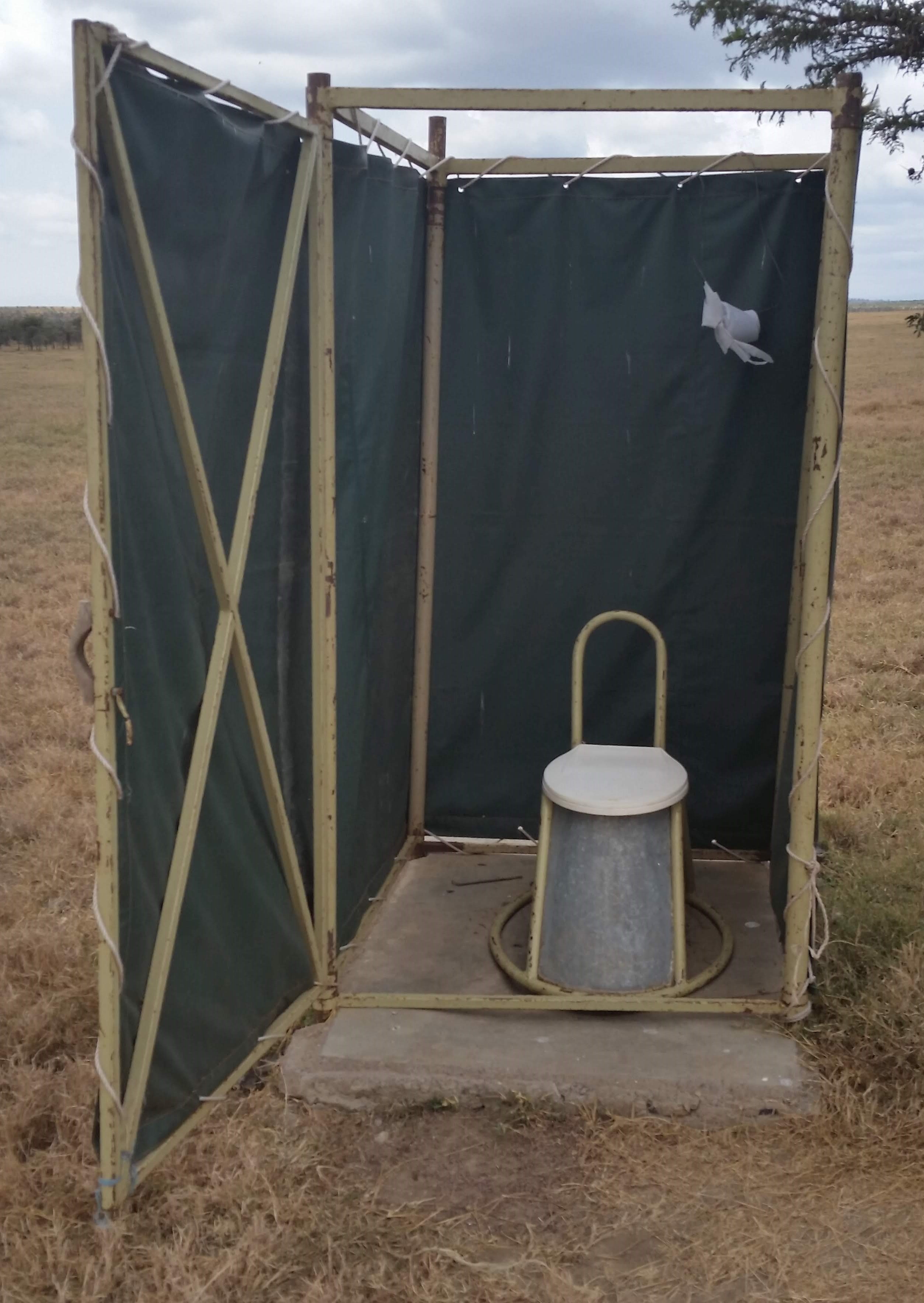
Airport “facilities
We should not have been surprised to find that the Kamok airstrip was little more than a level area in a wide expanse of grass, marked only by a windsock, an equipment shed, and an outhouse. A lone truck was parked nearby. We joked that a giraffe off in the distance was the air traffic control tower, and a scattering of zebras and warthogs were the ground crew.
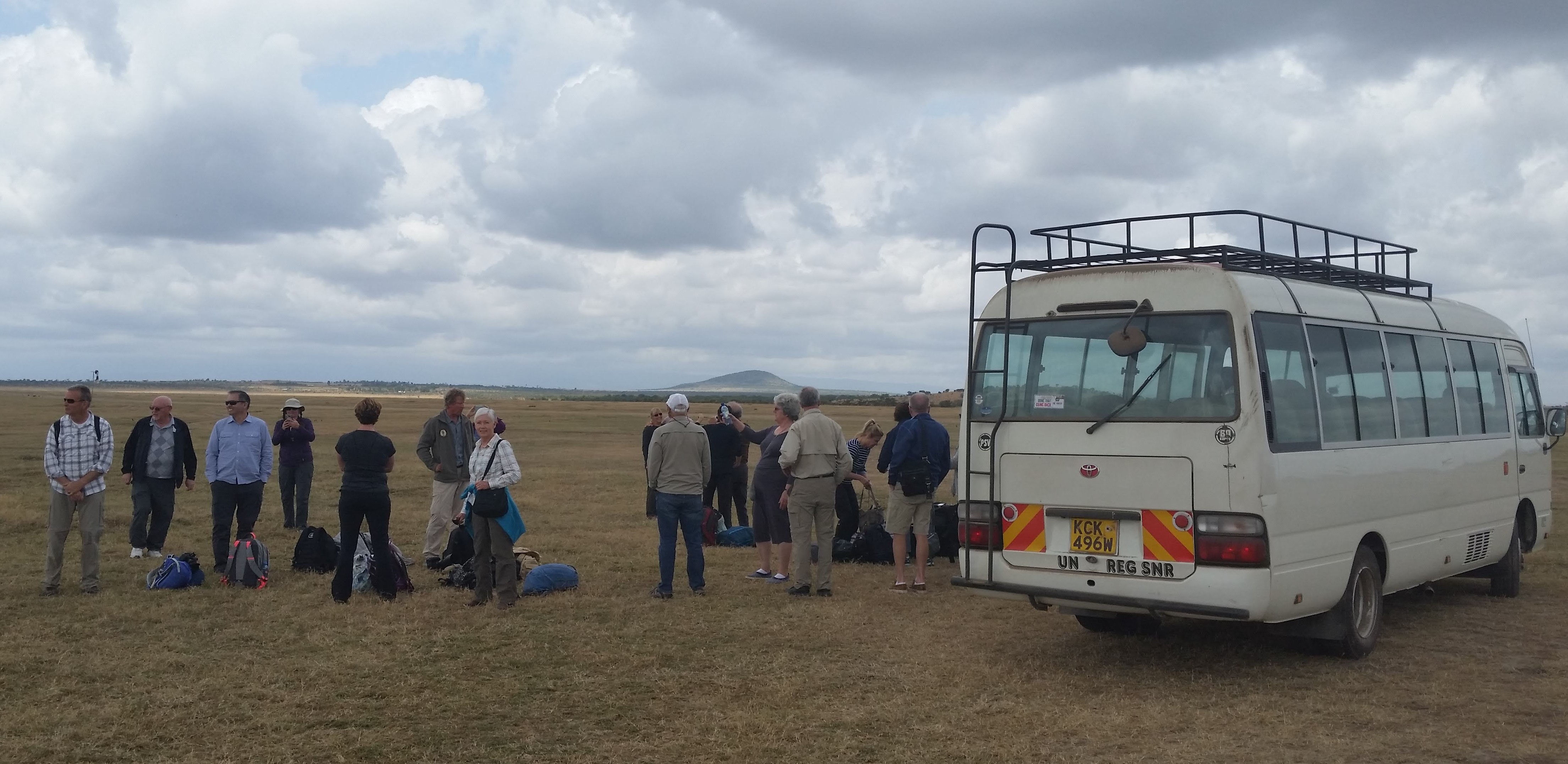
Waiting for our plane
We arrived about ten minutes before our scheduled flight, and then learned that we’d have to wait a while longer because the plane had been late leaving Nairobi.

Domestic cattle near the runway
There was nothing to do but stand around and talk, but it felt good to be outside and stretch our legs. As we scanned the horizon for a plane, we were surprised to see a herd of domestic cattle coming our way instead.
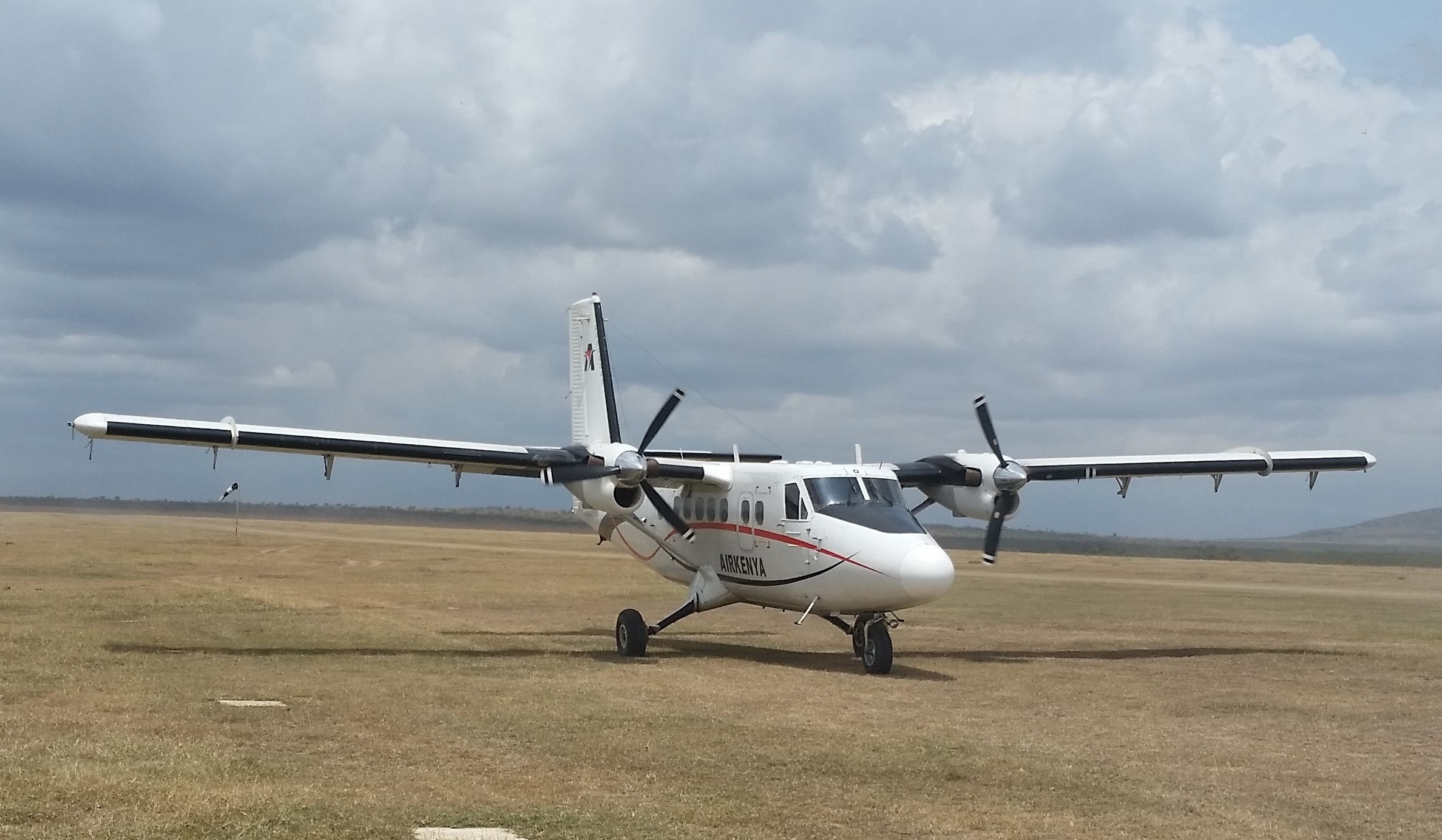
Our Twin-Otter
The sound of an approaching plane elicited some excitement until it came close enough for us to see that obviously it was not the twin-engine Otter we were expecting, but a two-passenger model. As soon as it landed, the pilot–a Conservancy official–climbed into the truck and drove away.
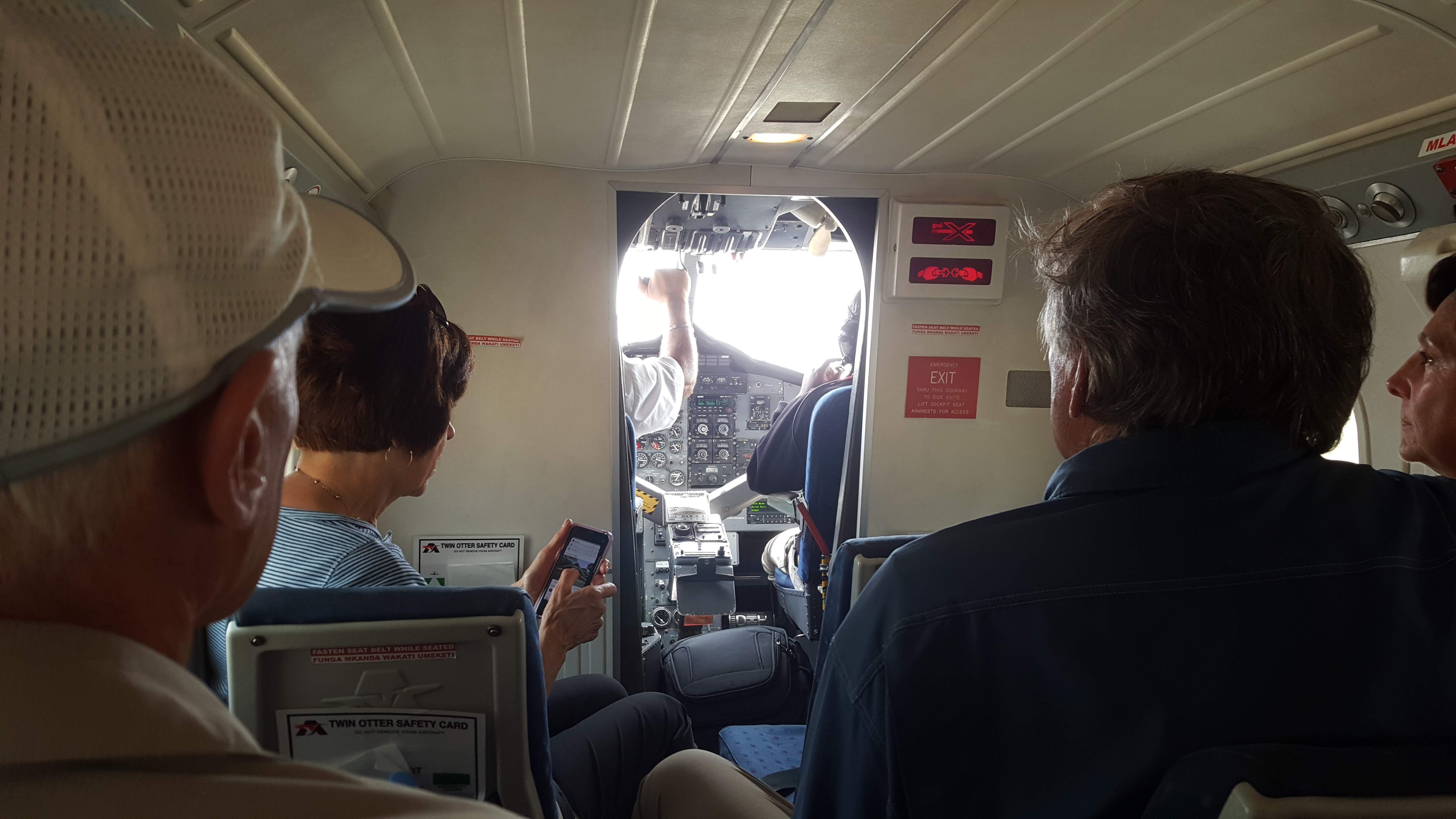
Cramped quarters inside the plane
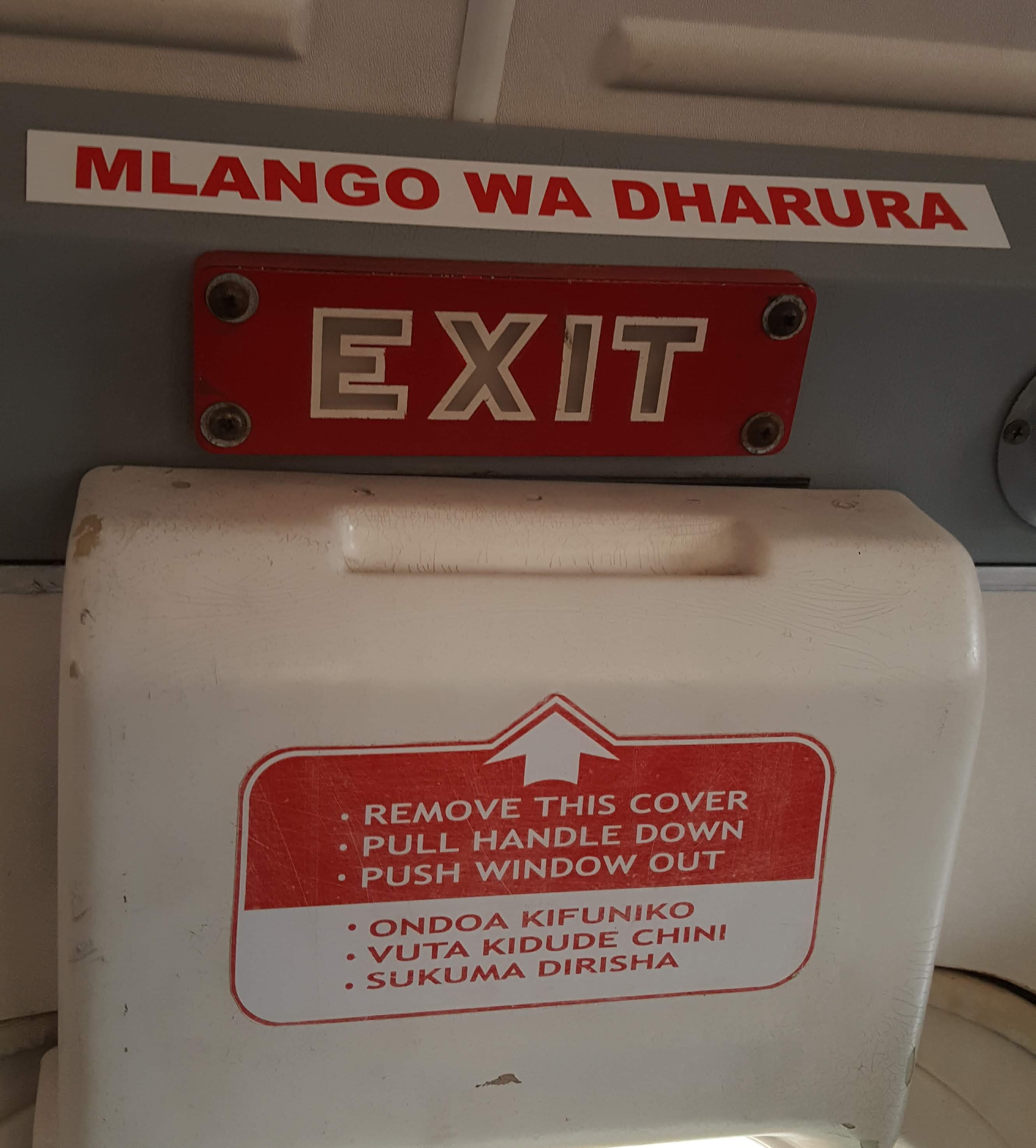
How often do you see plane instructions in English and Swahili?
We had waited more than an hour when the Twin Otter that would accommodate two-thirds of our group finally arrived. A second small plane operated by Air Kenya supposedly was right behind it, so sixteen of us went ahead and boarded the Otter. The co-pilot handed us a plastic container full of mints to pass around while she gave us the obligatory safety instructions, and by noon we were in the air. The view from 10,000 feet gave us a very different view of Kenya than we had seen from the highway and game reserve trails. Interspersed among semi-arid grasslands, lush green forests, and large agricultural plantations are patches of smaller farm plots, all creating a colorful crazy quilt on the land below.
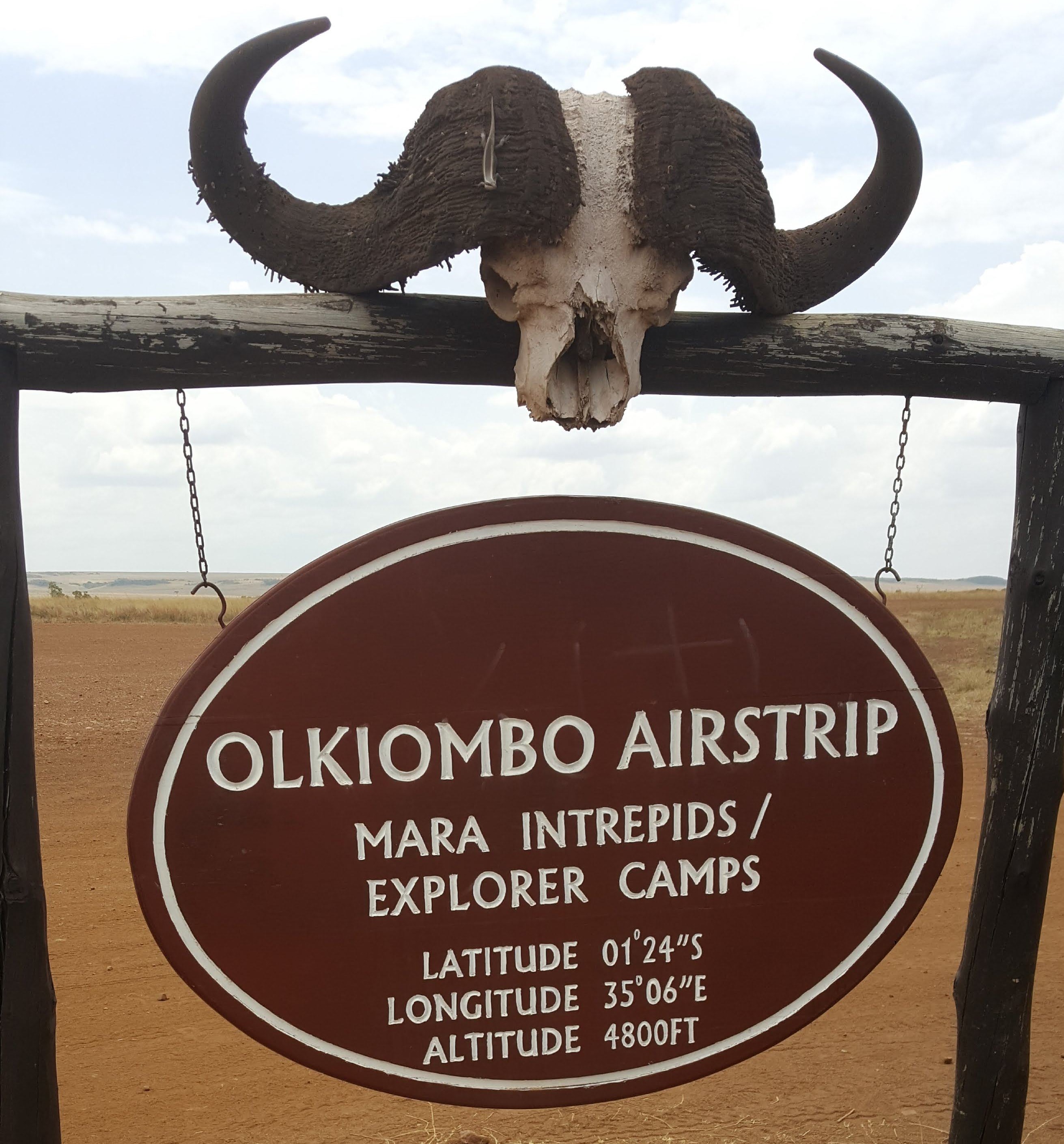
Welcome to Olkiombo Airport
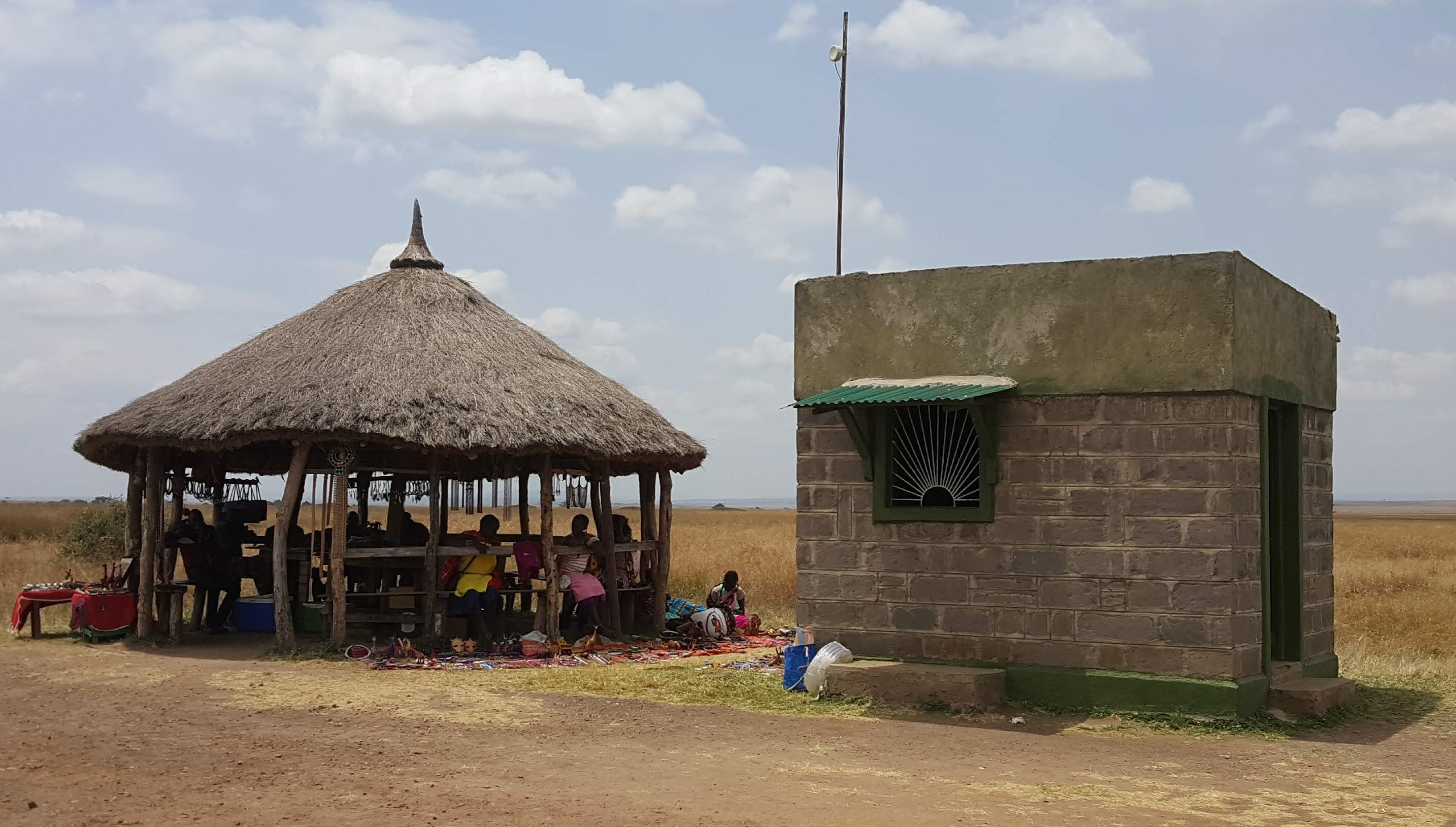
Olkiombo’s waiting shelter and amenities
An hour later, we touched down on the Olkiombo Airstrip near the Maasai Mara Reserve. As at Kamok, the runway had no tarmac, but Olkiombo did have a sheltered waiting area (complete with souvenir sellers, of course) and a more civilized washroom. We were happy to see our now familiar Land Cruisers and friendly drivers waiting in the parking area. Edwin told us that the second plane carrying the rest of our group was still some distance away, but said that those of us who had already arrived should go on ahead into the reserve. Nancy, Michael, Mark, and Lynn climbed into a vehicle driven by Amos, and soon we were on our way to discovering the Maasai Mara.
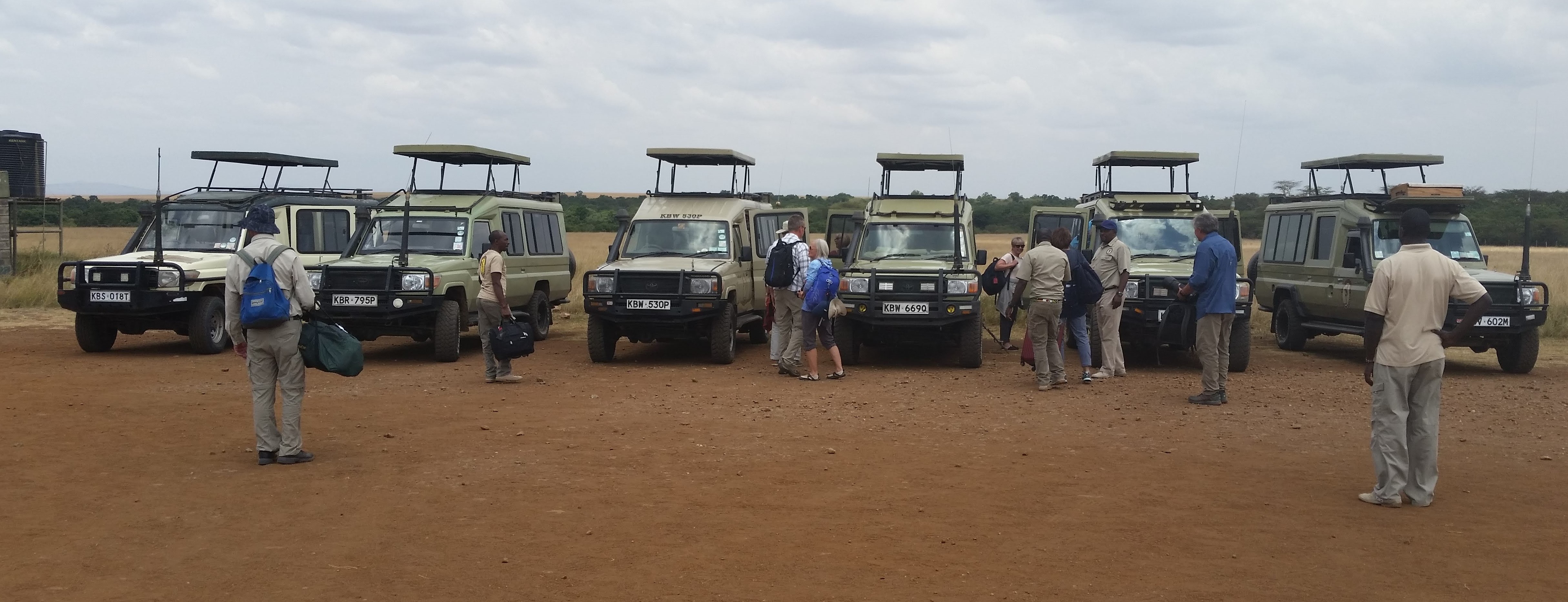
We were happy to see our “carriages” waiting at the airstrip
The Maasai Mara National Reserve is a 583-square-mile triangle on Kenya’s southern border, contiguous with Tanzania’s much larger Serengeti National Park. Kenya’s reserve is named for the region’s dominant tribe, and for its mara landscape (“spotted” in Maa, the Maasai language). The vast grassland is “spotted” not only with clumps of trees but also with animals, especially from July to October when more than a million wildebeests migrate north from the Serengeti in search of better grazing. Although Amos drove us straight to the Ashnil Mara Camp (“straight” being a figurative term, given the area’s tortuous roads), we must have seen a hundred thousand wildebeests on the way.

Wildebeest
Wildebeests are surely among the ugliest, dumbest animals alive. Their beards and manes are scraggly. Their legs look too thin to support their body weight but, ironically, they often appear emaciated because the irregular striations on their sides look too much like the rib cages of malnourished old men. Their dull eyes seem to disappear into their dark faces. Remember that line from The Lion King when Scar sings, “The lights are not all on upstairs?” He may have been referring to his hyena minions, but the sentiment is even more applicable to wildebeests. Their small brains render them incapable of any rational decision-making, and “crowdsourcing” only makes matters worse.

Maribou stork

Topis are distinguished by the bluish markings on their hind- and forequarters
Along the way, our guide pointed out a maribou stork, a family of topis, and venues of vultures of many varieties. (Fun facts: a flock of vultures at rest is called a “venue” or a “committee”; an airborne, circling flock is called a “kettle”; a feeding flock is called a “wake.”)

River crossing
Not far from the entrance to the camp, Amos executed a fairly rigorous river crossing. The water wasn’t very deep, but we had to drive over some big rocks that were anything but smooth.
“That wasn’t the Mara River, was it?” Nancy asked.
“No, that was the Talek,” said Amos. “The Mara is bigger.”
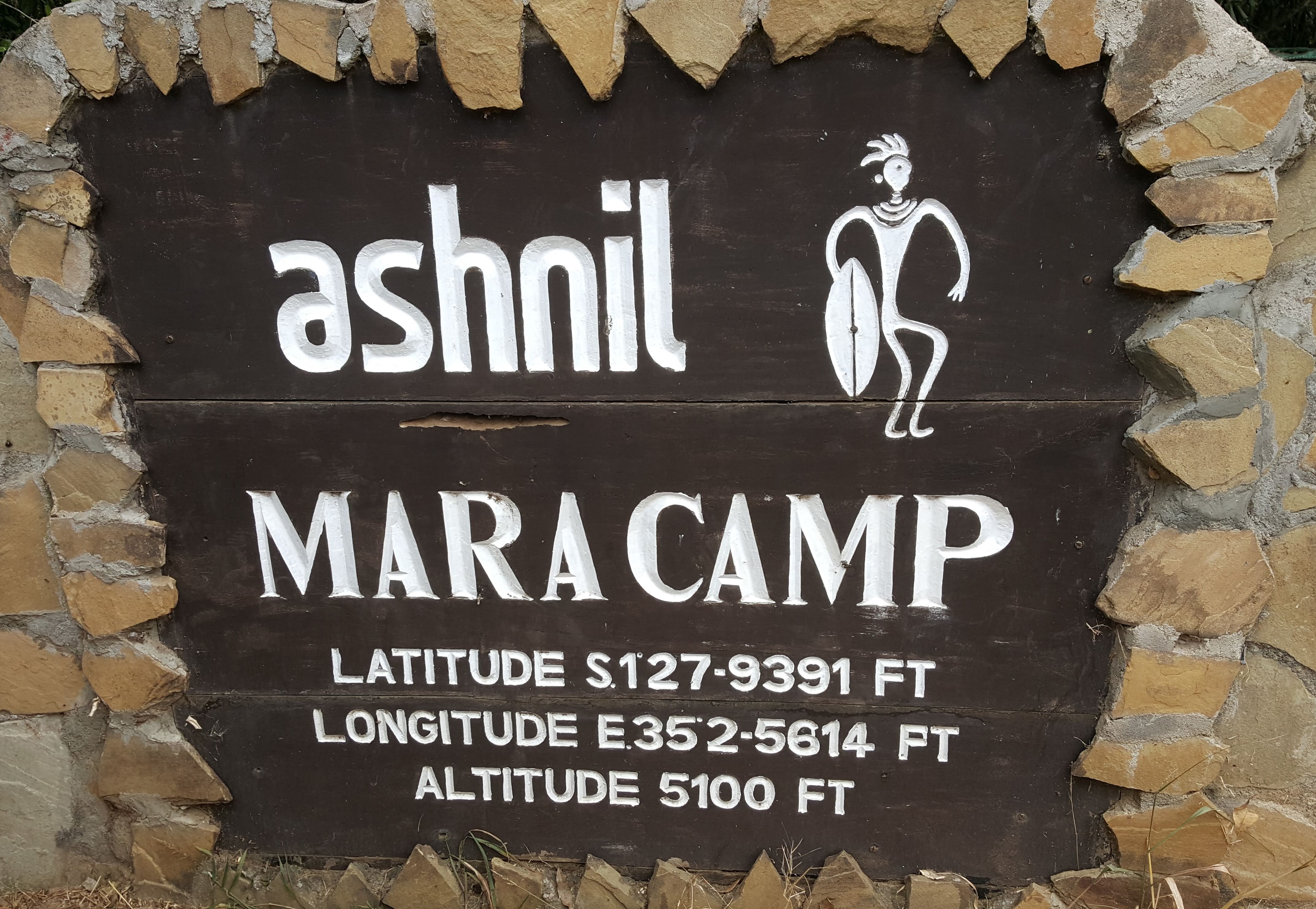
Welcome to Mara Camp
Because our plane had been so late, lunchtime was nearly over by the time we arrived at the Ashnil Mara
Camp, and we were hungry. Once again, there is a nice buffet that includes a stir-fry bar and a lot of Indian dishes, and the quality is close to that of Sweetwaters–good news! Mark, who loves spicy-hot food, raved over a dish labeled “Chili Danger.”
“I’m not sure exactly what’s in it,” he said. “Must be some kind of cheese. But it’s really good! Really, really good!” He took another mouthful.
“Would you be so enthusiastic if I told you that those white cubes are not cheese, but tofu?” Nancy asked.
“Tofu? You’re kidding!”
“I’m not kidding.”
“Then I guess I like tofu–if it’s in ‘Chili Danger’!” Mark decided.
Other diners raved over the jar of real maraschino cherries at the fruit and dessert bar that somehow Nancy had overlooked. She usually will eat the artificially red, artificially flavored fruit that Michael always picks off his sundaes, but she much prefers the real thing. “If you’ve never had a real maraschino cherry, you’ve got to try this,” she told Michael, and then was crestfallen when he said he thought they were only marginally better than the artificial kind.
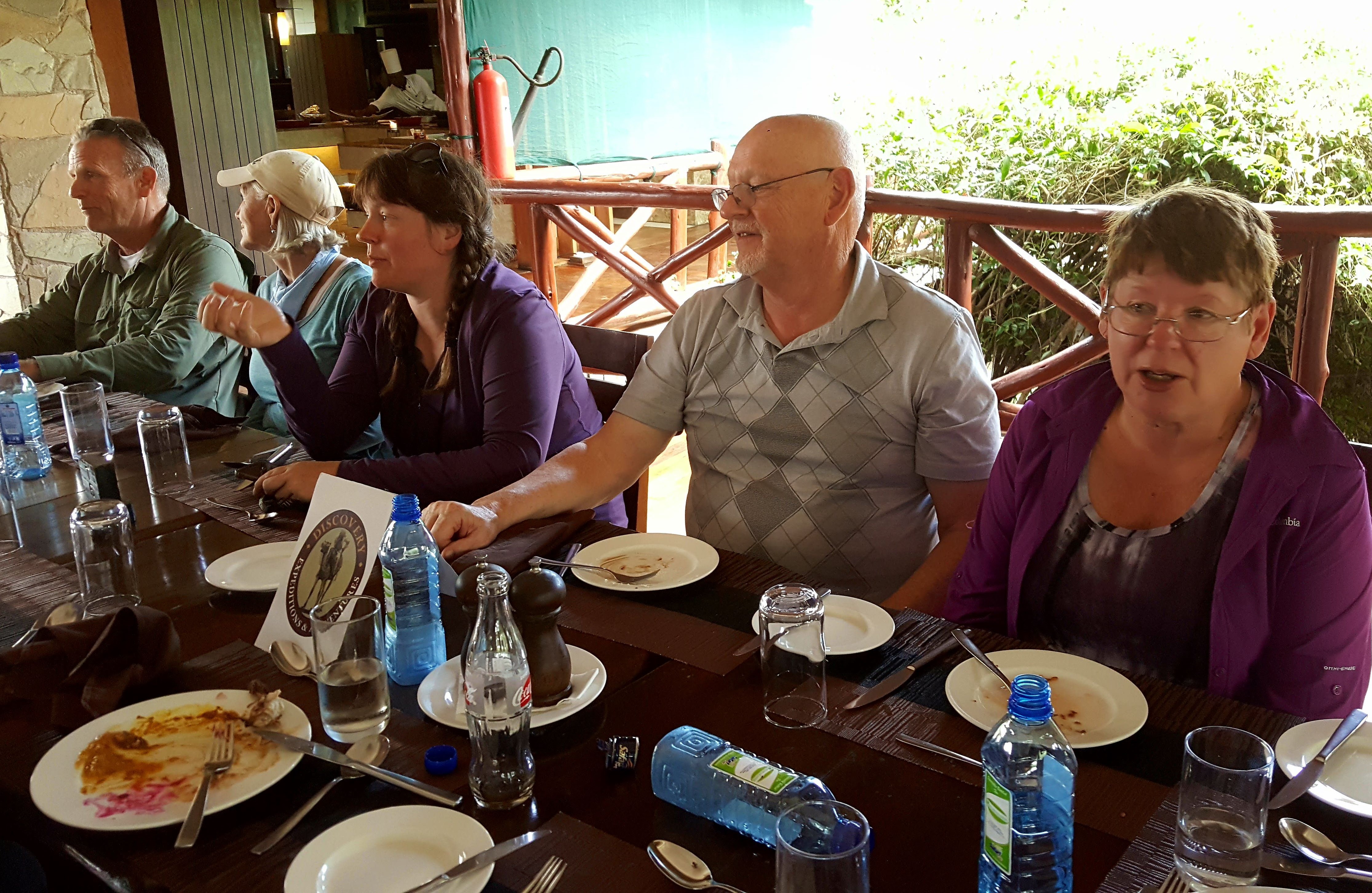
Paul, Jenny, Kara, Roger, and Norene in the Ashnil Mara Camp’s dining area
The Ashnil Mara’s lounge and dining area are in a covered pavilion that overlooks a shallow stretch of the river where several hippos had congregated for an afternoon wallow. Those of our group who had been on the second plane arrived while we were finishing lunch, so most of us had a while to get settled in our tents and rest while they ate.
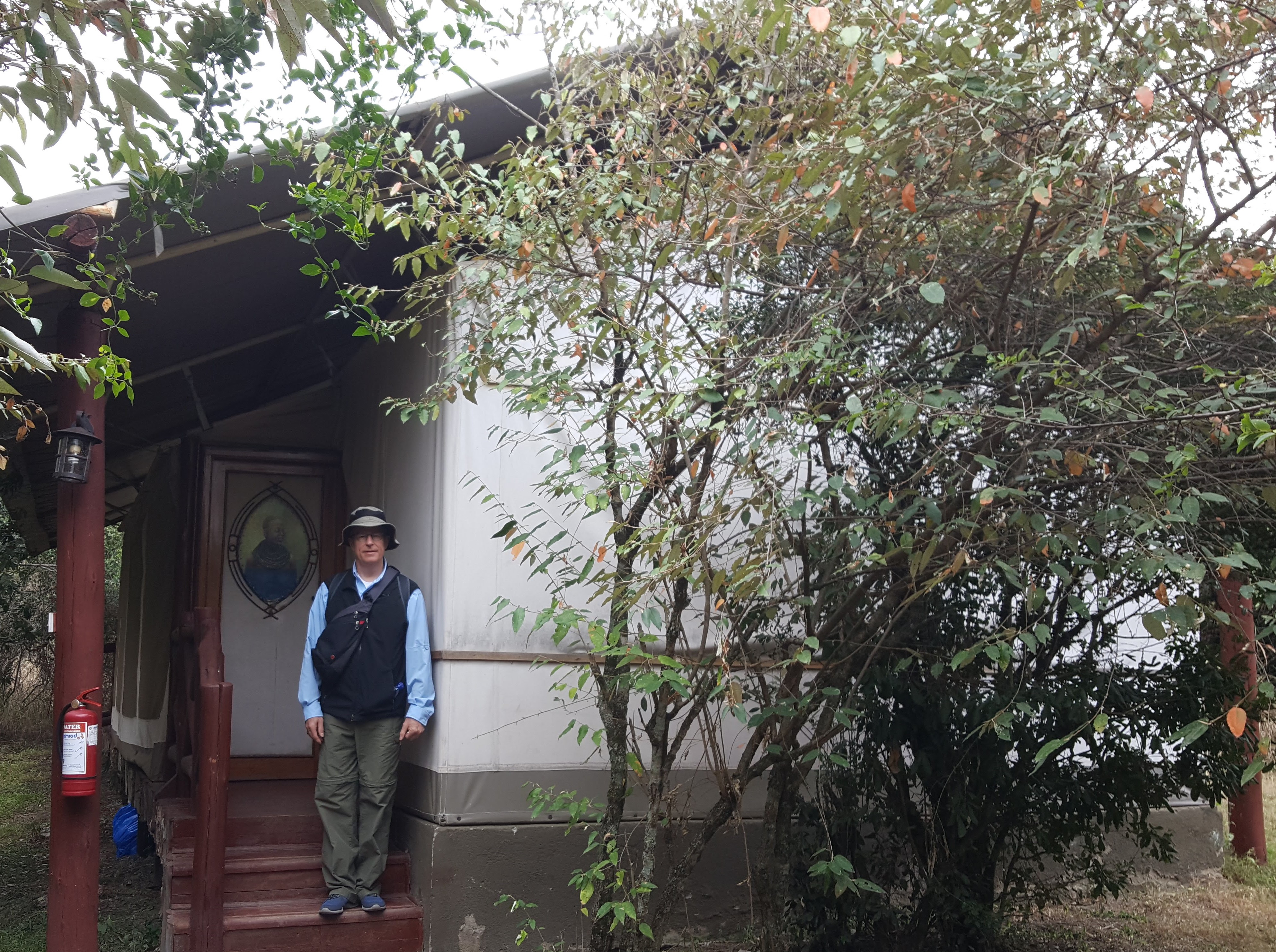
Our tent has a wooden door with a lock
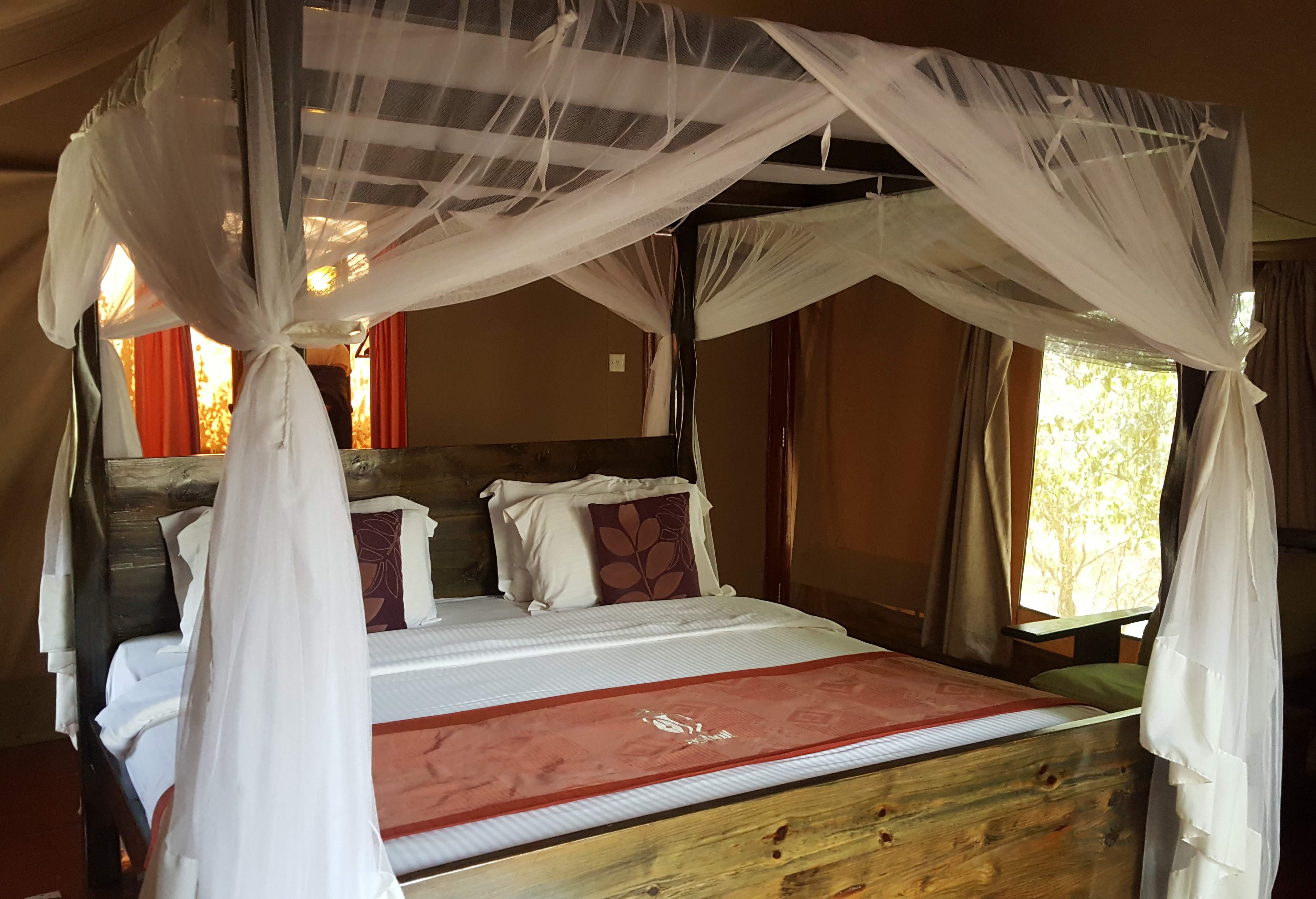
The canopied bed is in the center of the tent
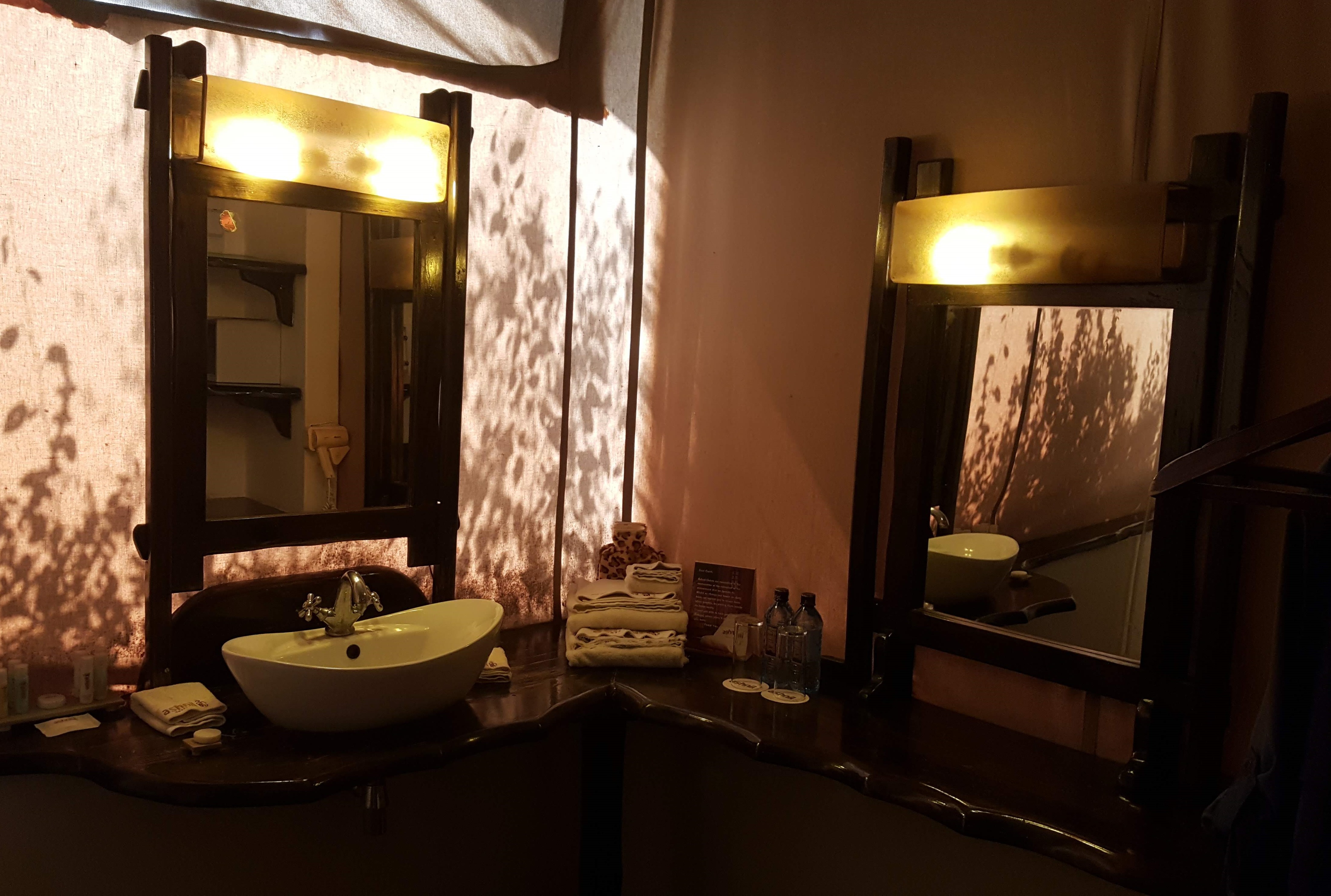
Our well-equipped bathroom. Sunlight on the trees outside creates shadow patterns on the canvas walls
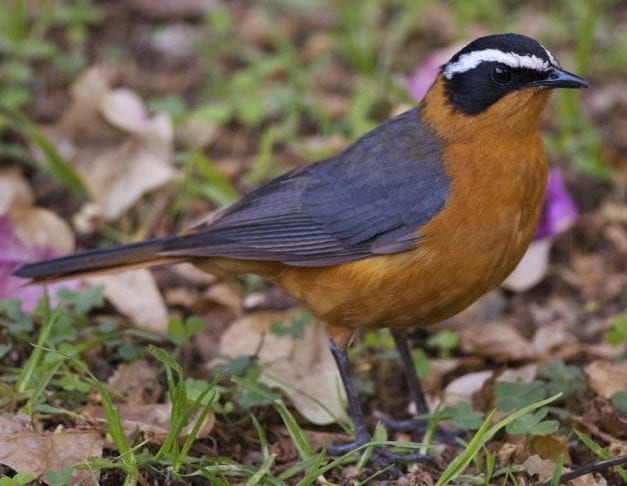
This white-browed robin-chat was twittering just outside our tent
Tents in the Ashnil Mara Camp are similar to those at Sweetwaters, except that here they are on raised platforms, and each tent has a wooden entry with a front door that locks. The beds have canopies draped with mosquito netting, although we haven’t noticed many airborne enemies–yet. Our back porch is surrounded by shrubbery, so we have privacy but no view.
During the 4 p.m. game drive we teamed with Jody and Dyrk, with Geoffrey as driver. Passing a nearby tower of giraffes, one of the first things we noticed was the difference in markings between these and the giraffes we had seen farther north.

Maasai giraffe
The reticulated giraffes we had seen previously look like they have white netting stretched over brown bodies; Maasi giraffes look like they have light upholstery covered with brown splotches. Geoffrey told us that the wrestling activity a couple of young ones were engaged in is called “necking.” We told him that in our culture, “necking” has a totally different meaning.

Lappet-faced vultures
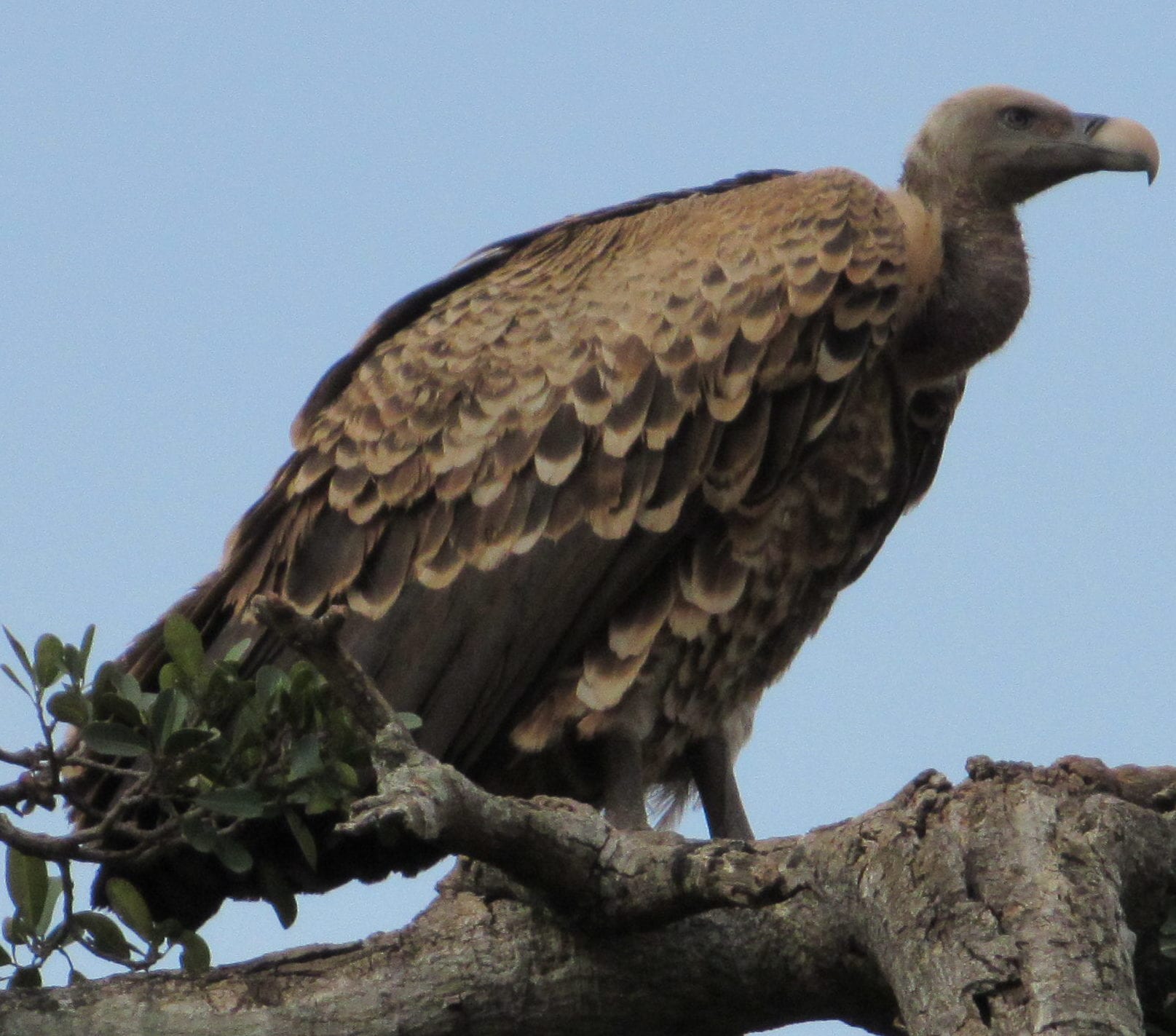
Rüppel’s griffon vulture
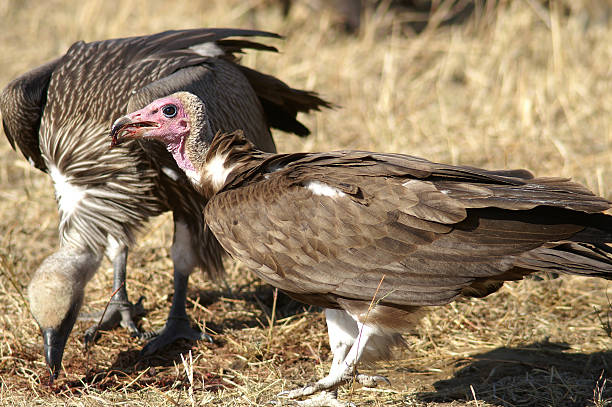
Hooded Vulture
The Mara region’s bird population seems to be weighted more toward meat-eaters than songbirds. Vultures come in several varieties, so Geoffrey gave us a lesson on their hierarchy: lappet-faced vultures (so called because of the flap of skin at the base of their bare heads) are the biggest.
They get priority seating at a carcass once the hyenas have moved on, but that seems to be okay with the other vultures because the lappet-faces are better at tearing away the hide, making it easier for the other birds to feed later. When the lappet-faces have had their fill, the griffons get a turn, and finally the smaller hooded vultures. None of these birds are very polite; if someone tries to get ahead of the regular sequence, the offender will be hissed away.
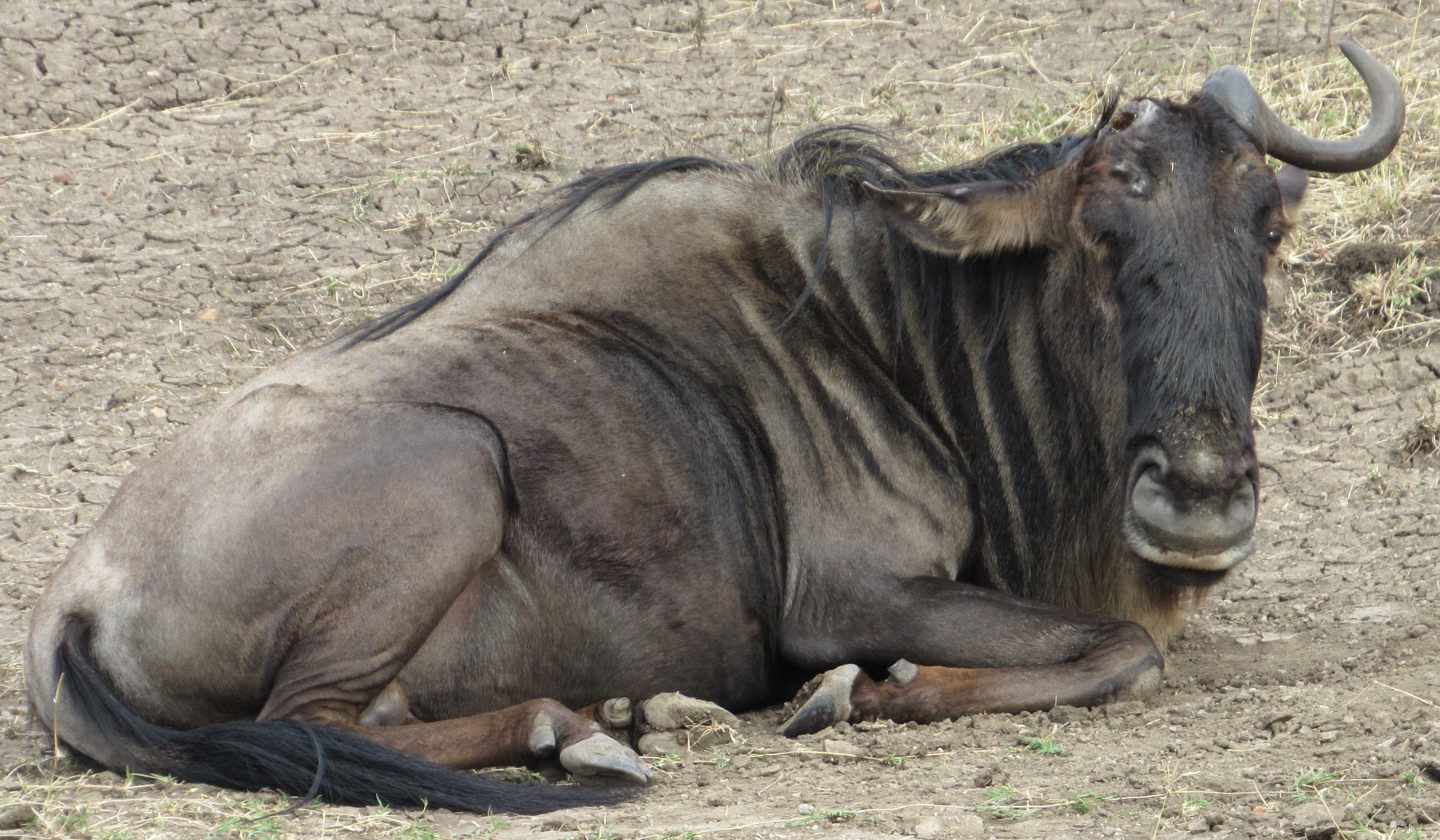
Lone, wounded wildebeest
As we drove toward the Mara River, we saw a lone wildebeest huddled on the ground and apparently unable to move. One of its horns was missing. No doubt the vultures would be holding a “wake” for the poor beast within the next twenty-four hours.

Yellow-billed stork

Brown snake eagle
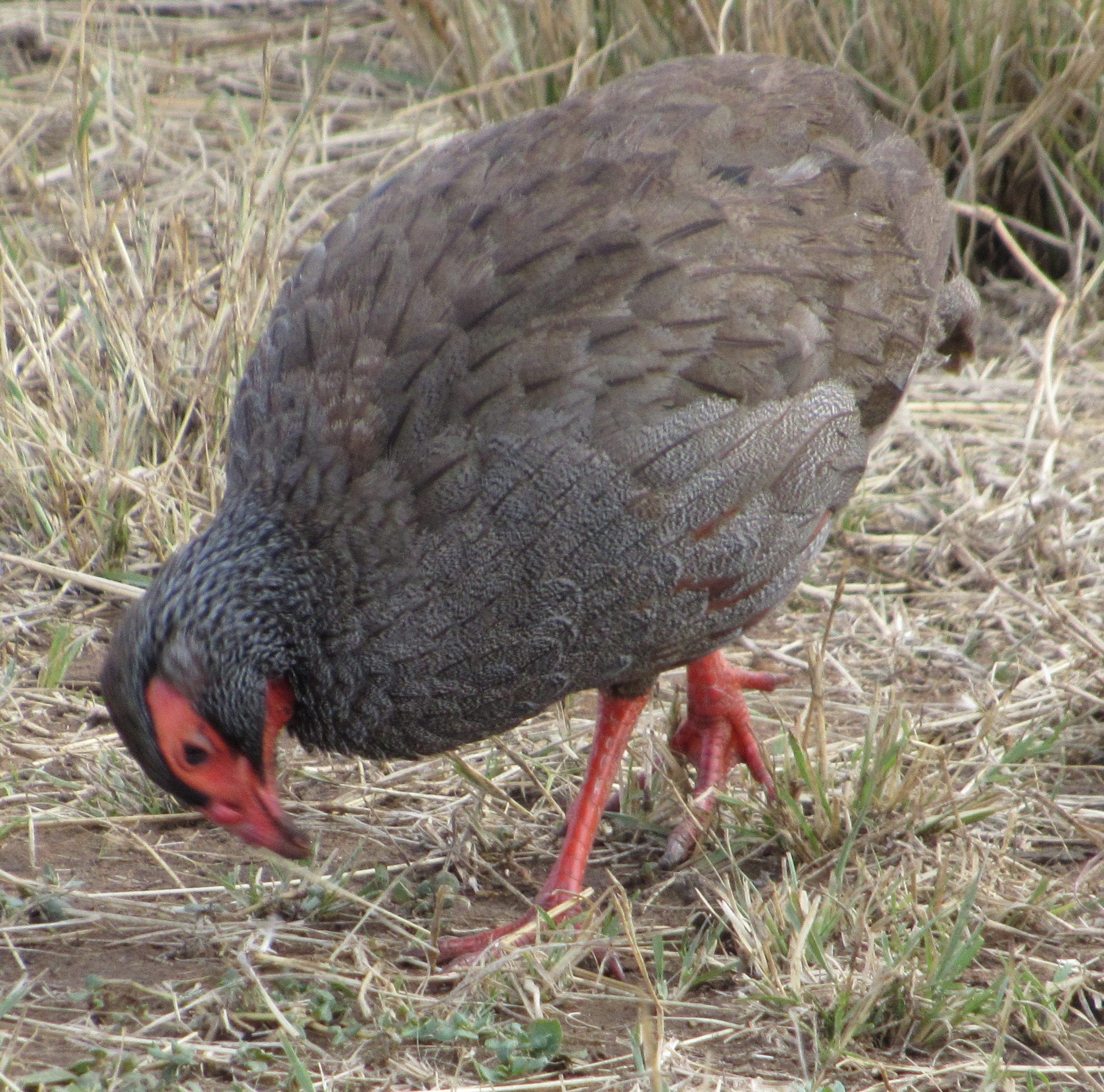
Red-necked spurfowl
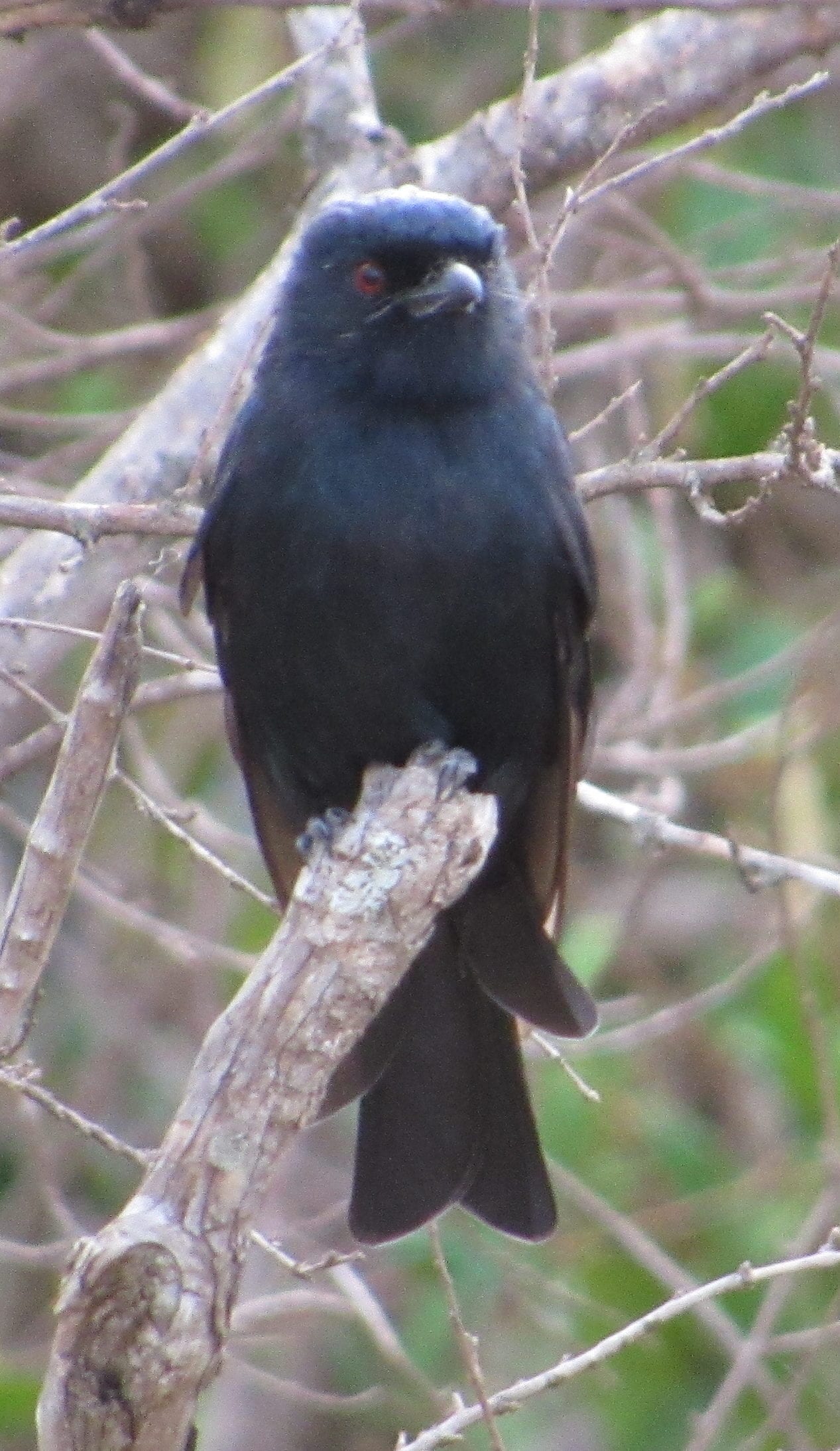
Southern black flycatcher
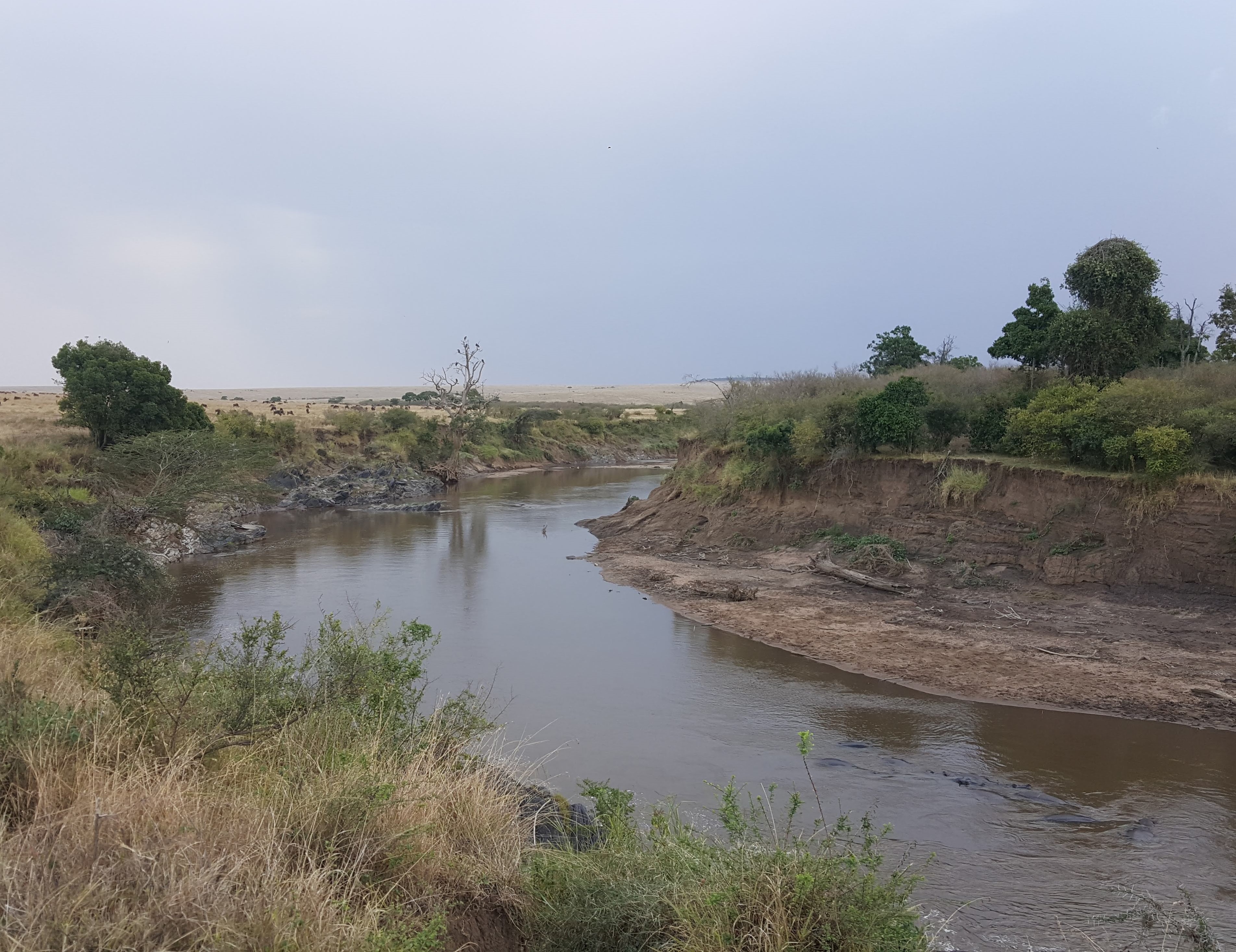
A bend in the Mara River
Rain clouds were beginning to appear on the horizon when we parked on a cliff overlooking the river to enjoy the panorama, which included a school of hippos placidly lounging in the water below us.

Hippo exposes only its eyeballs and ears
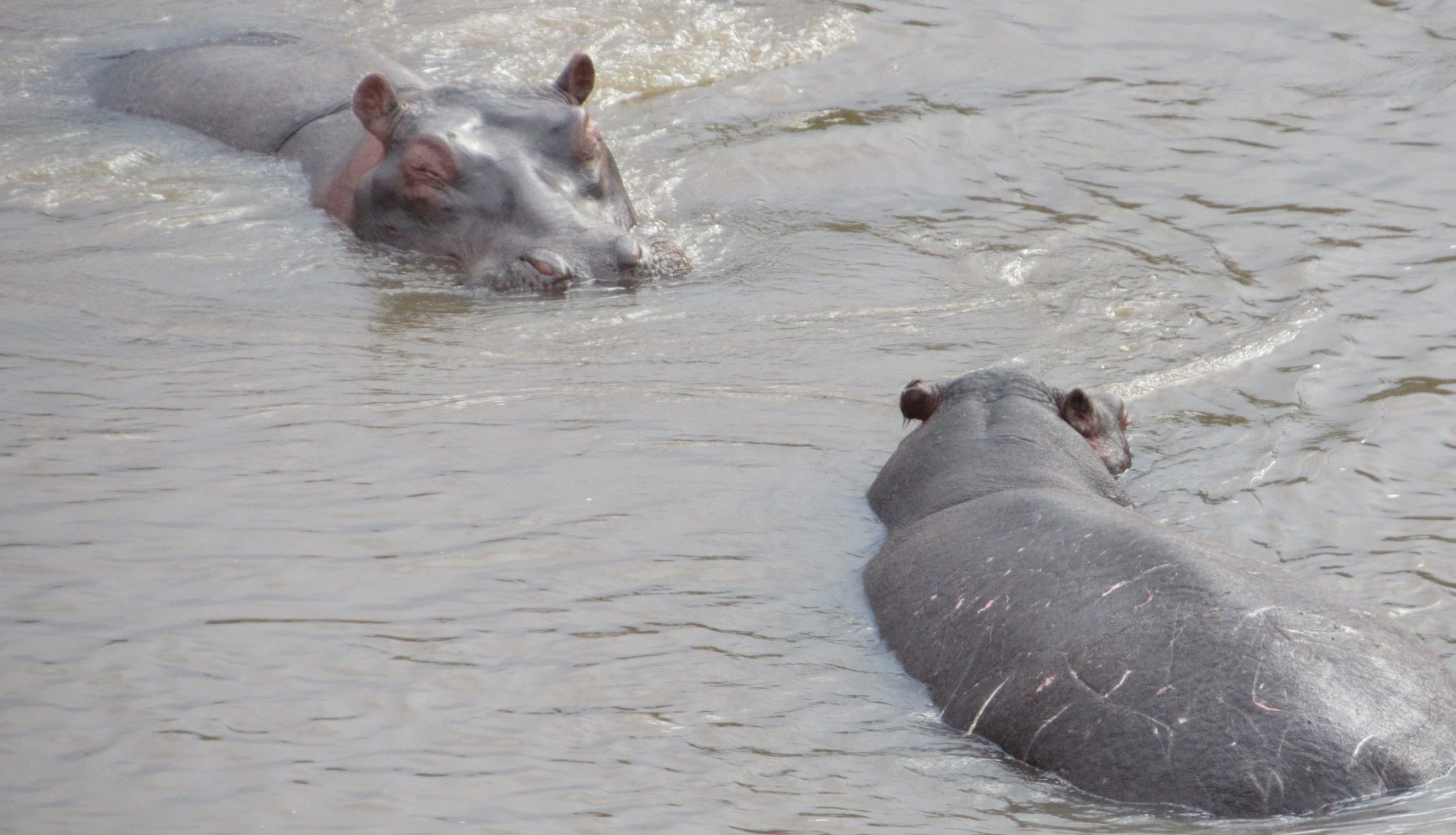
Wading hippos
A few were on a nearby sandbar, but most of them were submerged up to their eyeballs, occasionally flipping flies from their little round ears. Nancy recalled the animatronic hippos in Disneyland’s Jungle Cruise, one of her favorite rides when she was a kid. A line in the river guides’ regular spiel warned that “hippos are only dangerous when they wiggle their ears”–and then, of course, the animatronic ears would begin to wiggle, and the guide would shoot his cap gun to “subdue” the dangerous beasts. When she told Amos what the Disneyland guides had said about hippos’ ears and asked if it were true, he just laughed. Later, however, Jim told us that more humans are killed in Africa by hippos than by any other animal. Although their bodies are bulky and their legs short, hippos can move quickly when provoked, and the four big teeth in their powerful jaws can be formidable weapons. Indeed, just last week, a Chinese tourist bent on getting a close-up photo of a hippo on the shore of Kenya’s Lake Naivasha died after the hippo chomped down on him. We are quite content to stay in our Land Cruisers and observe the animals through telephoto lenses.
Suddenly, without warning or any apparent reason, the hippos we were watching started raising a ruckus, splashing and jostling one another. A minute later, just as inexplicably, they all settled down and went back to lounging near the sandbar as if nothing had happened. We never determined why.
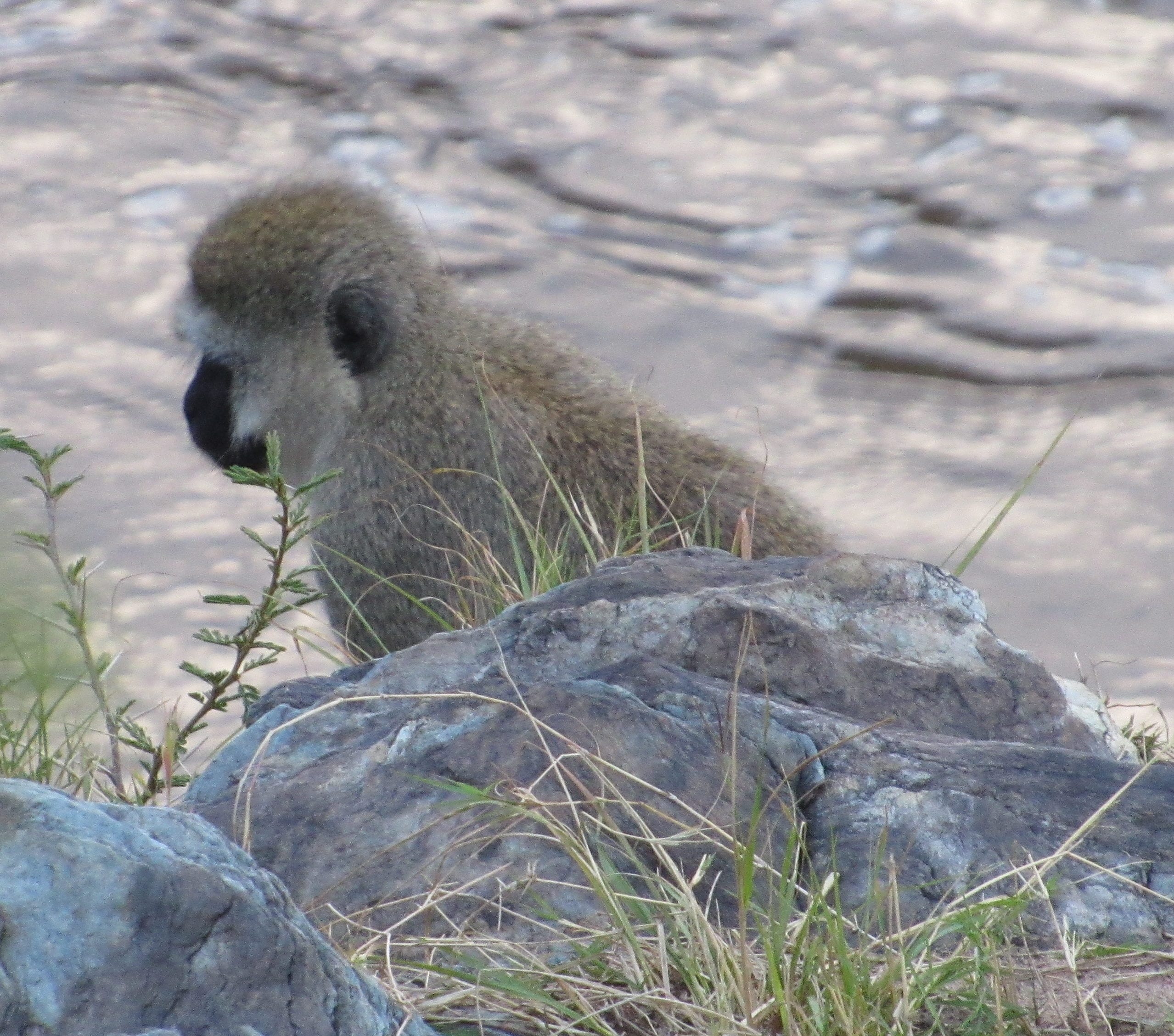
Vervet monkey
Meanwhile, a few vervet monkeys scampered on the rocks near the water’s edge. They never seem to lounge, and therefore are very challenging to photograph.
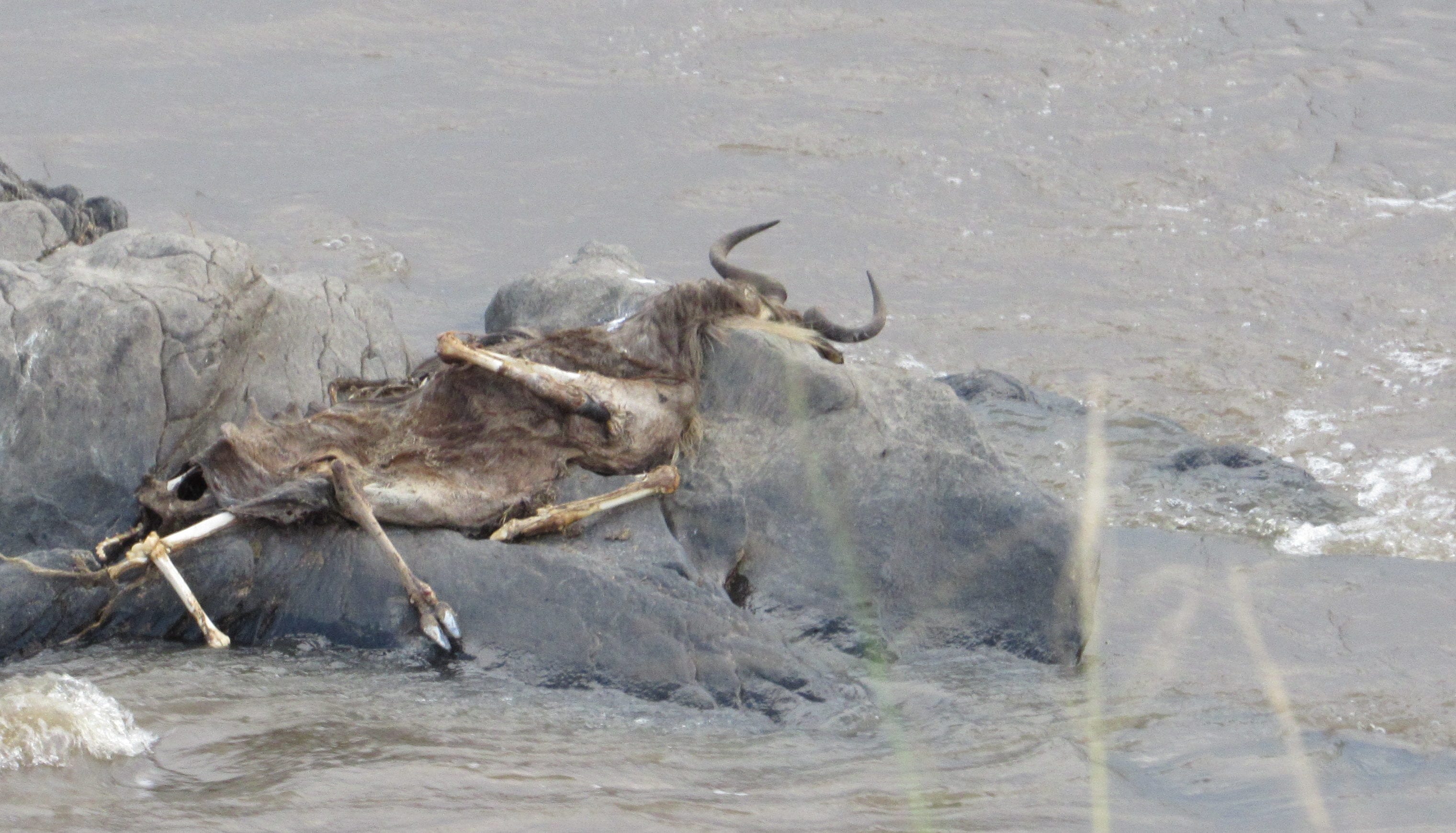
Remains of a wildebeest who failed the crossing
On a rock on across the river, we could see the bony remains of a wildebeest that obviously had not made a successful crossing. One of the unique features of an African safari at this time of year is the chance to see hundreds of wildebeests stampede down an escarpment, hell-bent for a drink and the promise of better grazing on the other side of the river. We hope to witness such a dramatic crossing tomorrow.
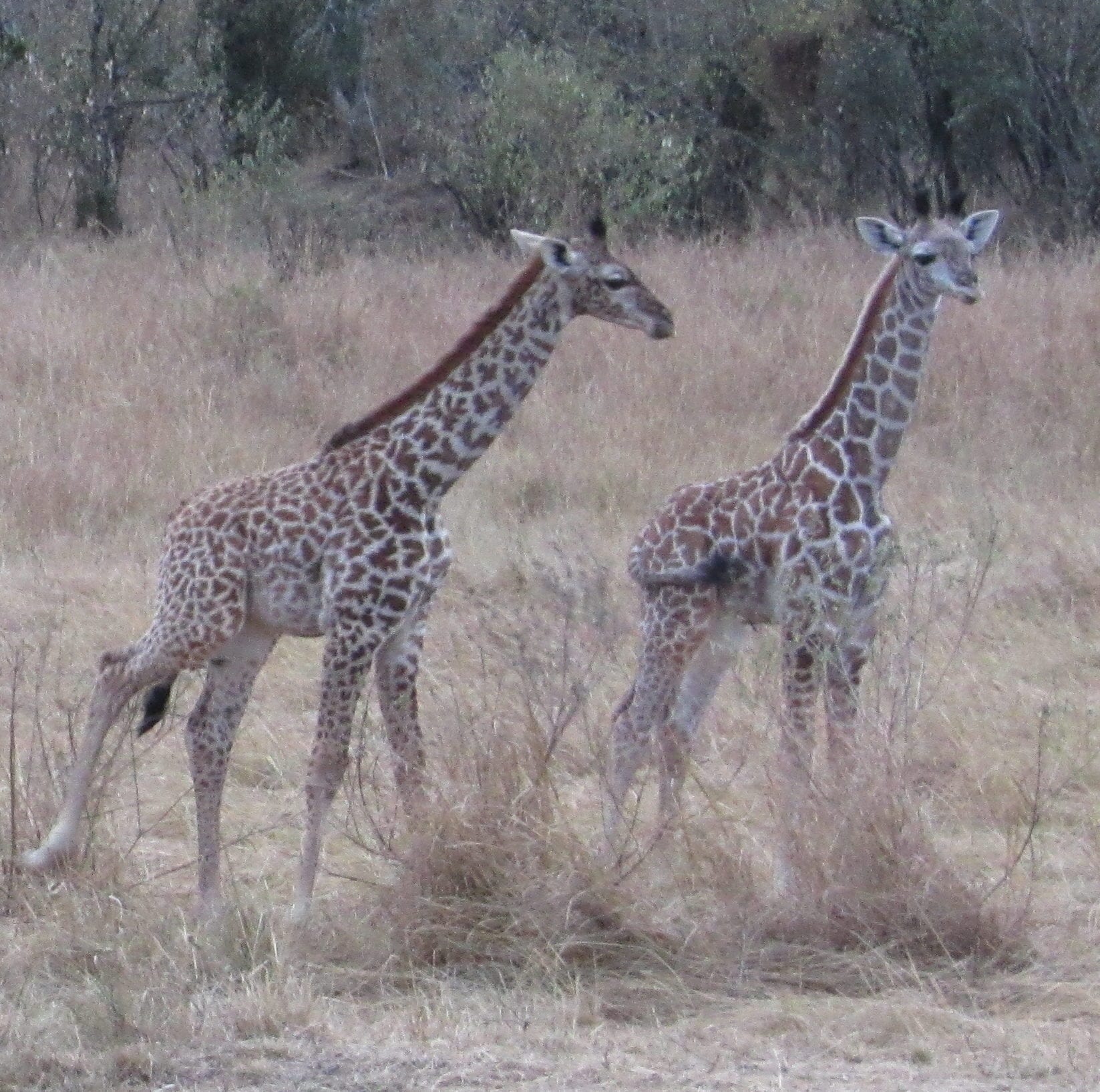
Geoffrey estimated that these giraffes were less than four months old
On our way back to the lodge before sundown, we passed a couple of baby giraffes, and a pair of lions who looked well-fed. With so many wildebeests dotting the plains, how could they not be?
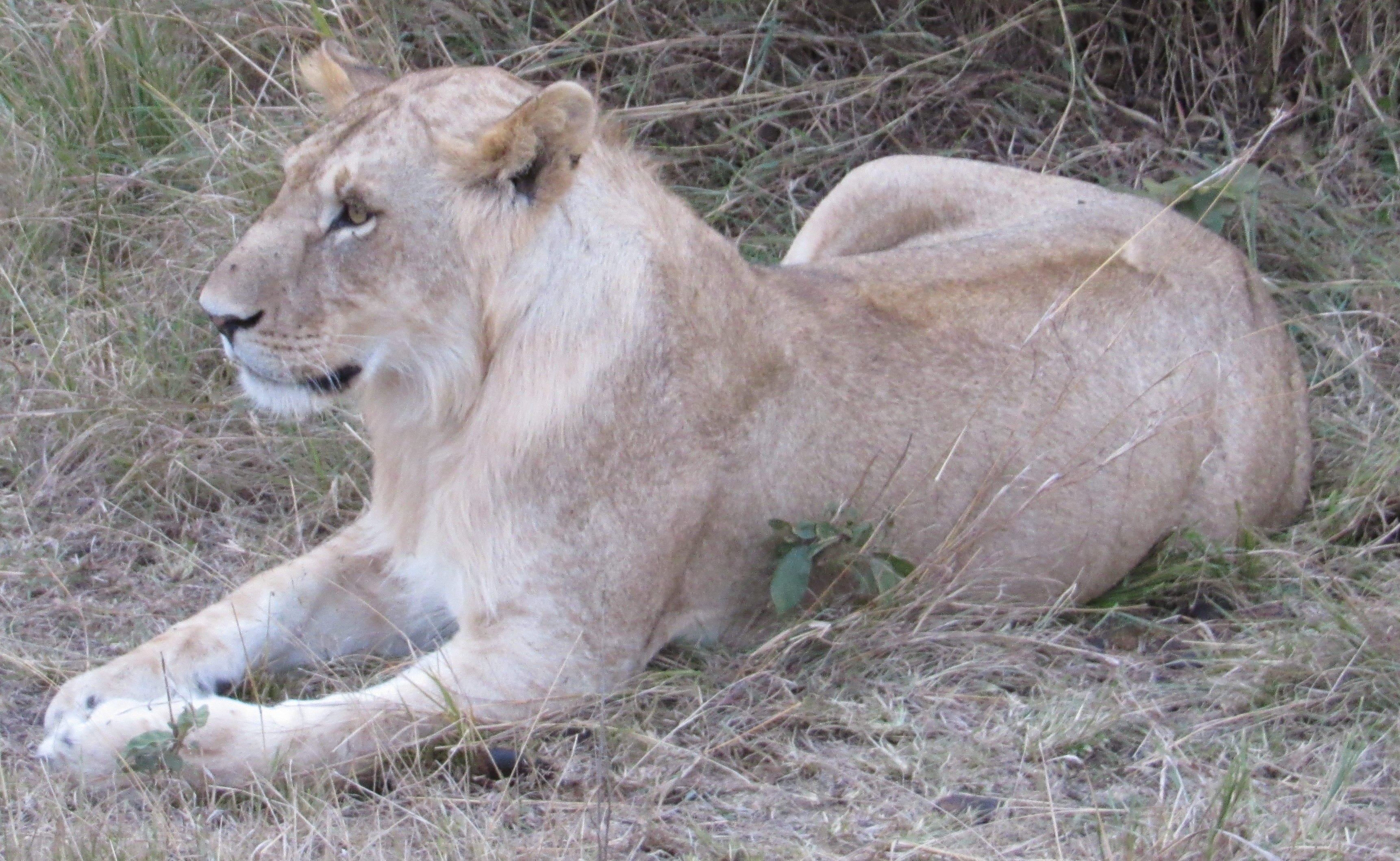
Pair of content . . .
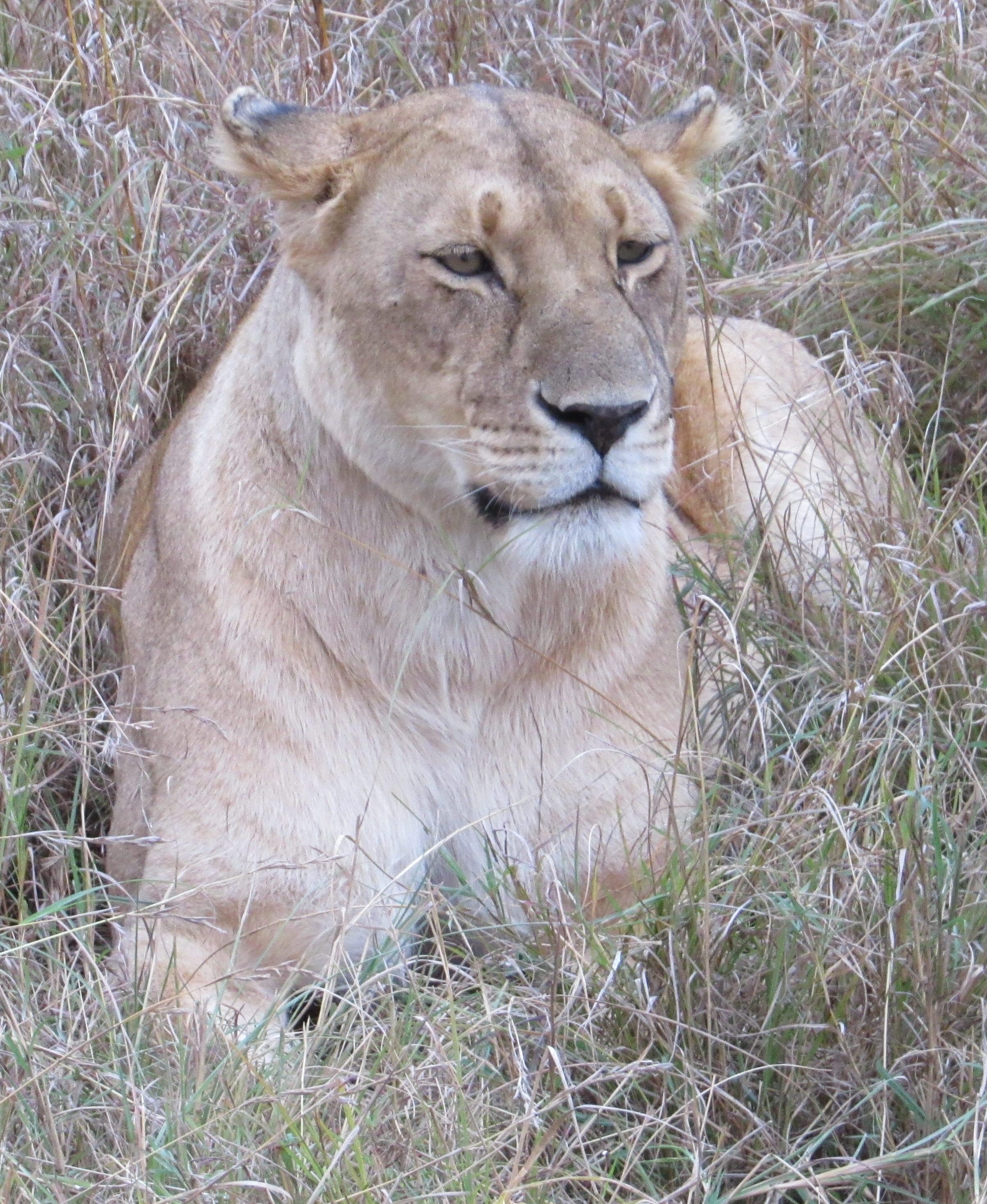
. . . and well-fed lions
We had a while before dinner to take advantage of the wifi in the bar area. As dusk turned to dark and the lights in the lounge came on, however, we were horrified to see a horde of mosquitos hovering overhead. Nancy–ever aware of her lack of immunity to yellow fever–had already applied insect repellent to her exposed skin, but Michael had not, so he went back to the tent to amend that oversight, leaving his tablet aglow on the table.
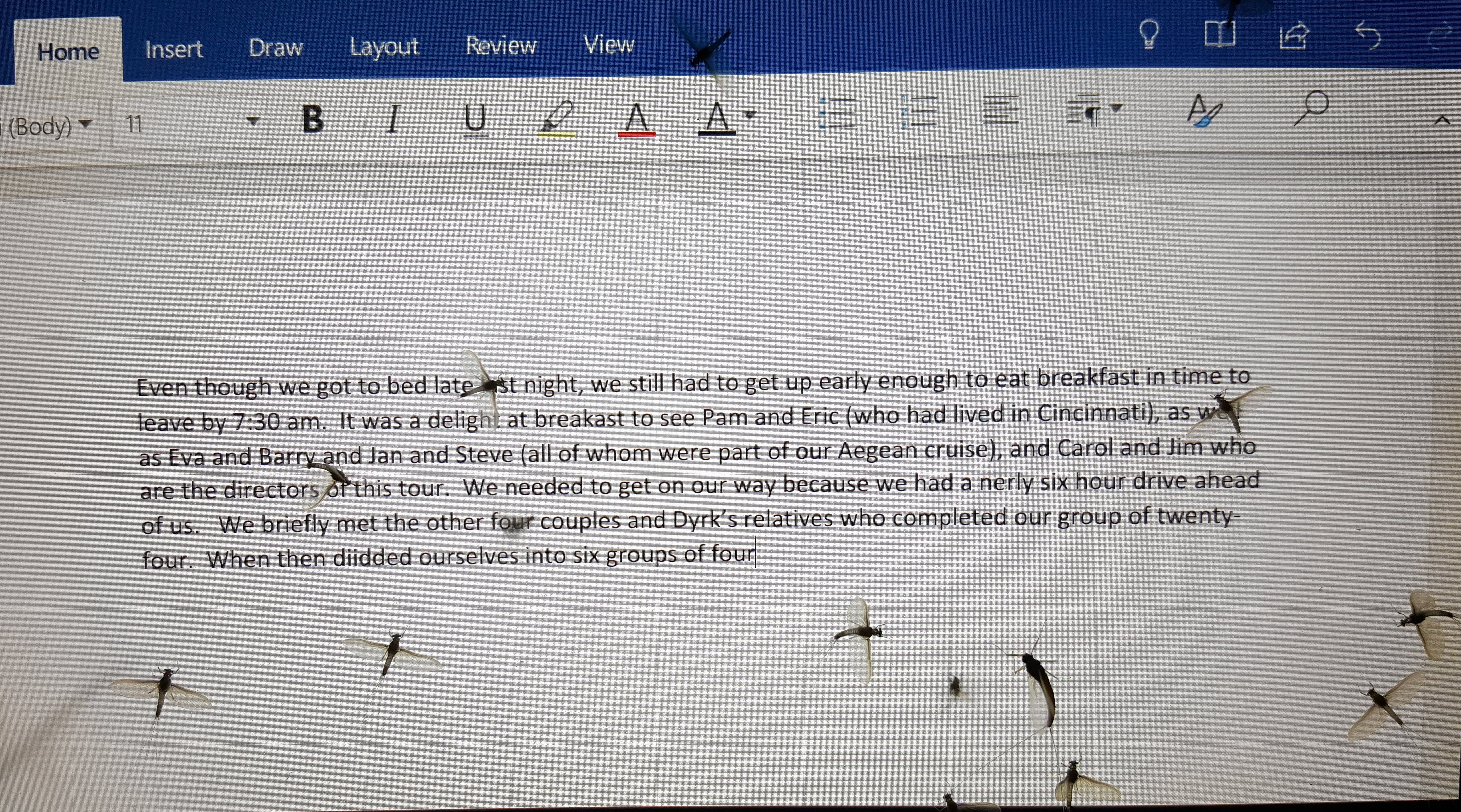
Midges attracted to Michael’s glowing tablet
While he was gone, Nancy noticed that the little flies seemed more attracted by the light emanating from our devices and the overhead lamps than they were by the opportunity for a blood meal. Later we learned that these flies were not mosquitoes but non-biting midges. Even though we needn’t have worried about contracting yellow fever from them, they were hugely annoying.
On the other hand, the midges in the dining area tonight were not any more annoying than the tourists from a certain part of the world that shall remain unnamed in our blog lest we be accused of racism. We have frequently noticed during our travels that this particular group has a very different sense of courtesy, propriety, and personal space than we do, often manifest when angling for a good photograph, or elbowing their way to the front of a line. Their pushiness at a buffet tempts us to compare them with a wake of vultures. We have learned how to firmly stand our ground when necessary, but usually it’s easier to just bow out of their way.
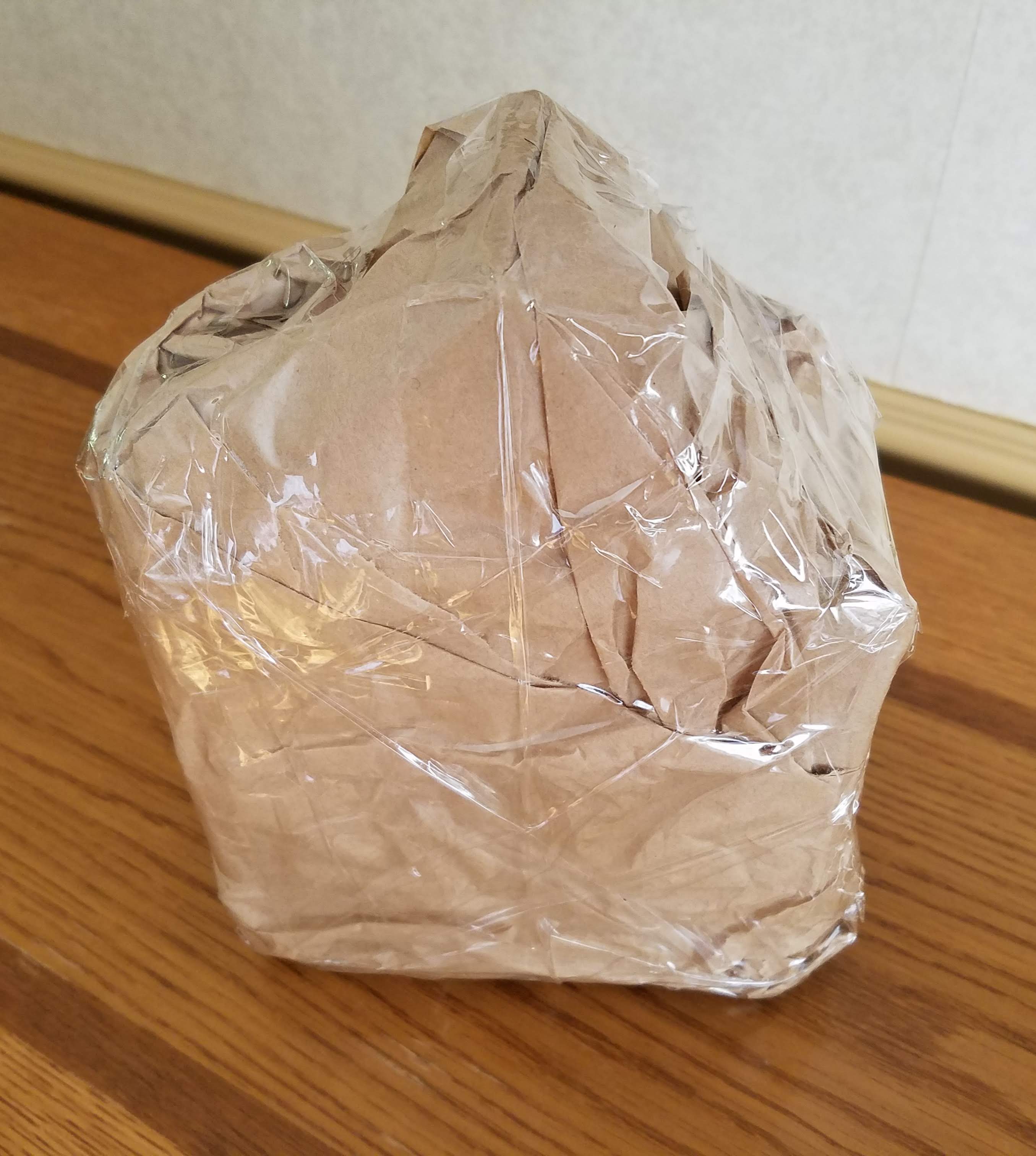
The shop clerk made certain that the nativity set we purchased was prepared to survive any mishap short of an atomic explosion
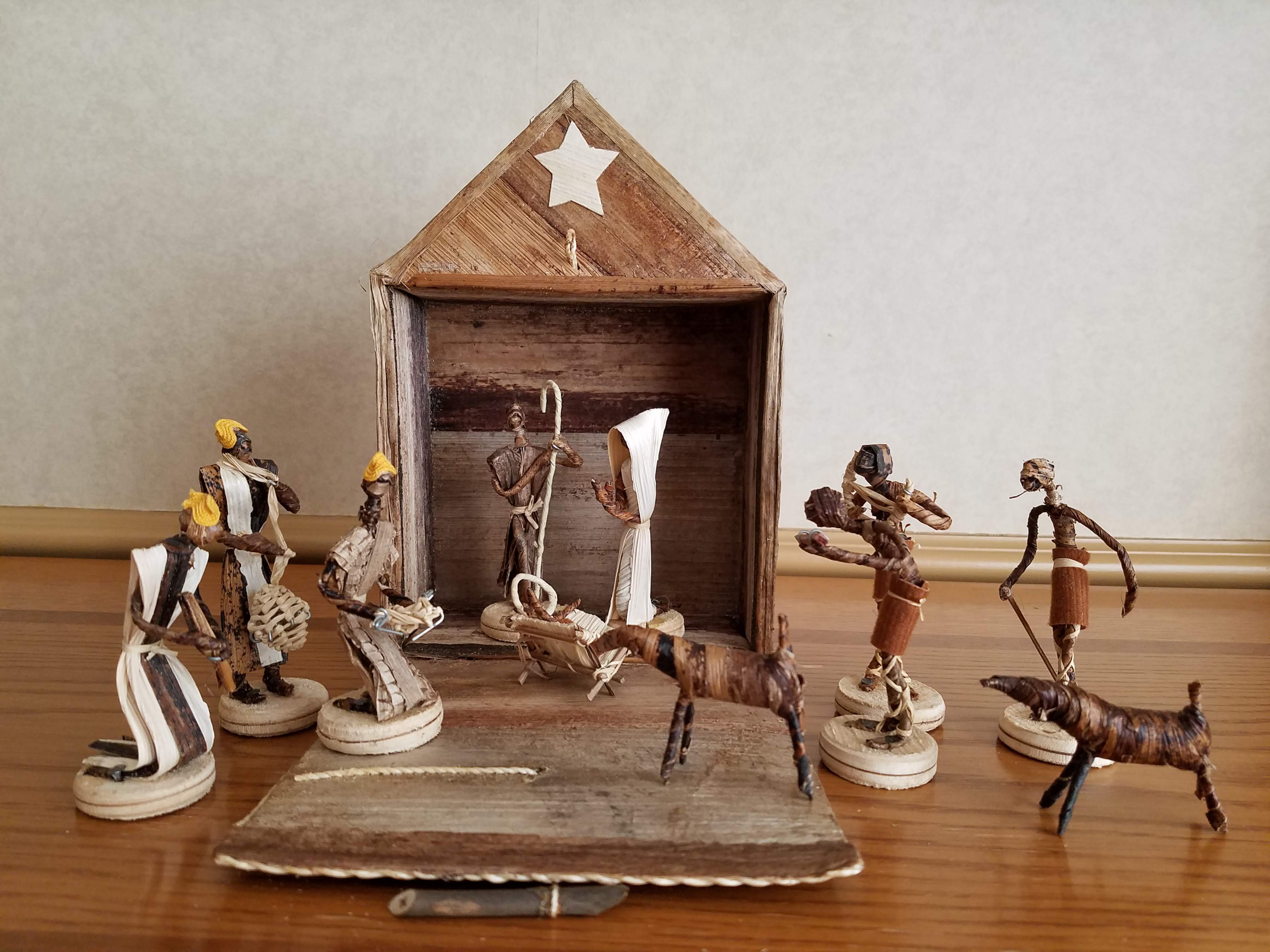
Banana-leaf nativity, unwrapped
After dinner we visited the gift shop adjacent to the lounge, where we bought a small nativity set with figures made from banana leaves. Michael hoped to find a new bush hat but, as is often the case, even an extra-large wasn’t big enough for him.
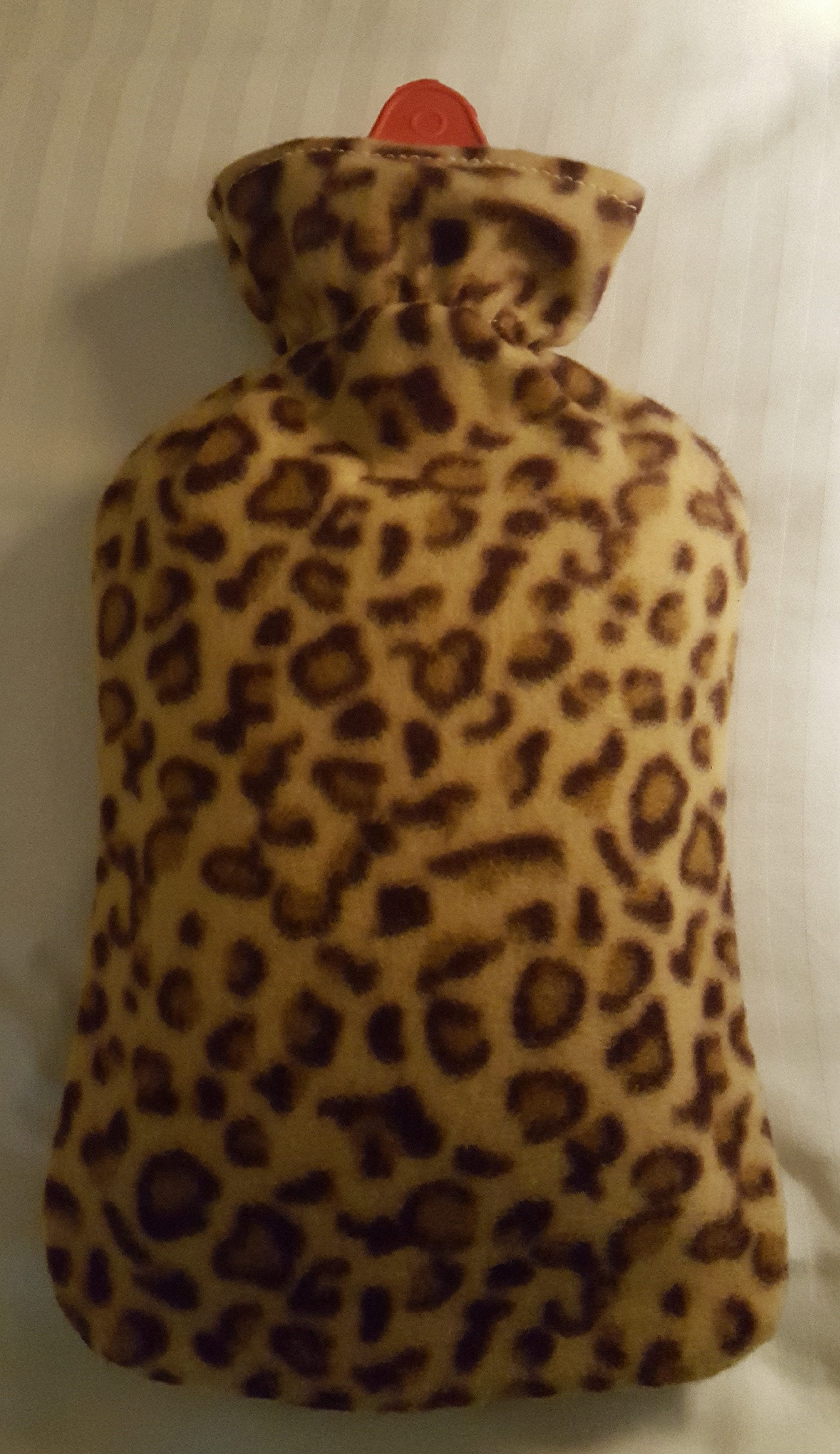
Ashnil’s hot-water flasks have leopard spots
Light rain had begun to fall by the time we decided to turn in, so we had to hurry through the dark along the stone path leading to our tent. Roland, our housekeeper, had not only removed the bedspread and turned down the sheets, but also unfurled the mosquito netting around the bed. He had brought a hot-water flask, too, although we aren’t sure we will need it because it isn’t as chilly here in the Maasai Mara as it had been in Sweetwaters. One thing Roland hadn’t done was remove a tiny gecko that somehow had found its way into our bathroom. Michael used a paper bag to capture it so he could escort it outside, where we were sure it would be happier.
Now our main concern is whether we can find the gap in the mosquito netting in case we need to get up and use the bathroom during the night.
Narration is so well done. It just brings the trip back to life again. What an amazing talent. Thank you for sharing.